ecosystem-guides.com
....exploring the planet's ecosystems
AUSTRALASIAN
Tropical Open Woodlands
This section covers the open forest and woodlands across tropical northern Australia and southern New Guinea. At first this habitat seems empty, especially compared to the similar habitats and their large mammals in tropical Africa and Asia, but it it very varied and diverse.
Despite the similarity in appearance of tropical open woodlands around the world, the species composition is quite different. For example, the open tropical forest and savanna woodlands may be dominated by Acacia and elephants in southern Africa, and by Eucalyptus and kangaroos in Australia, but they both appear physically similar. The two images of savanna woodlands show this parallel development in similar conditions; on the left is India, on the right is Australia. (Or maybe it is the other way around?)
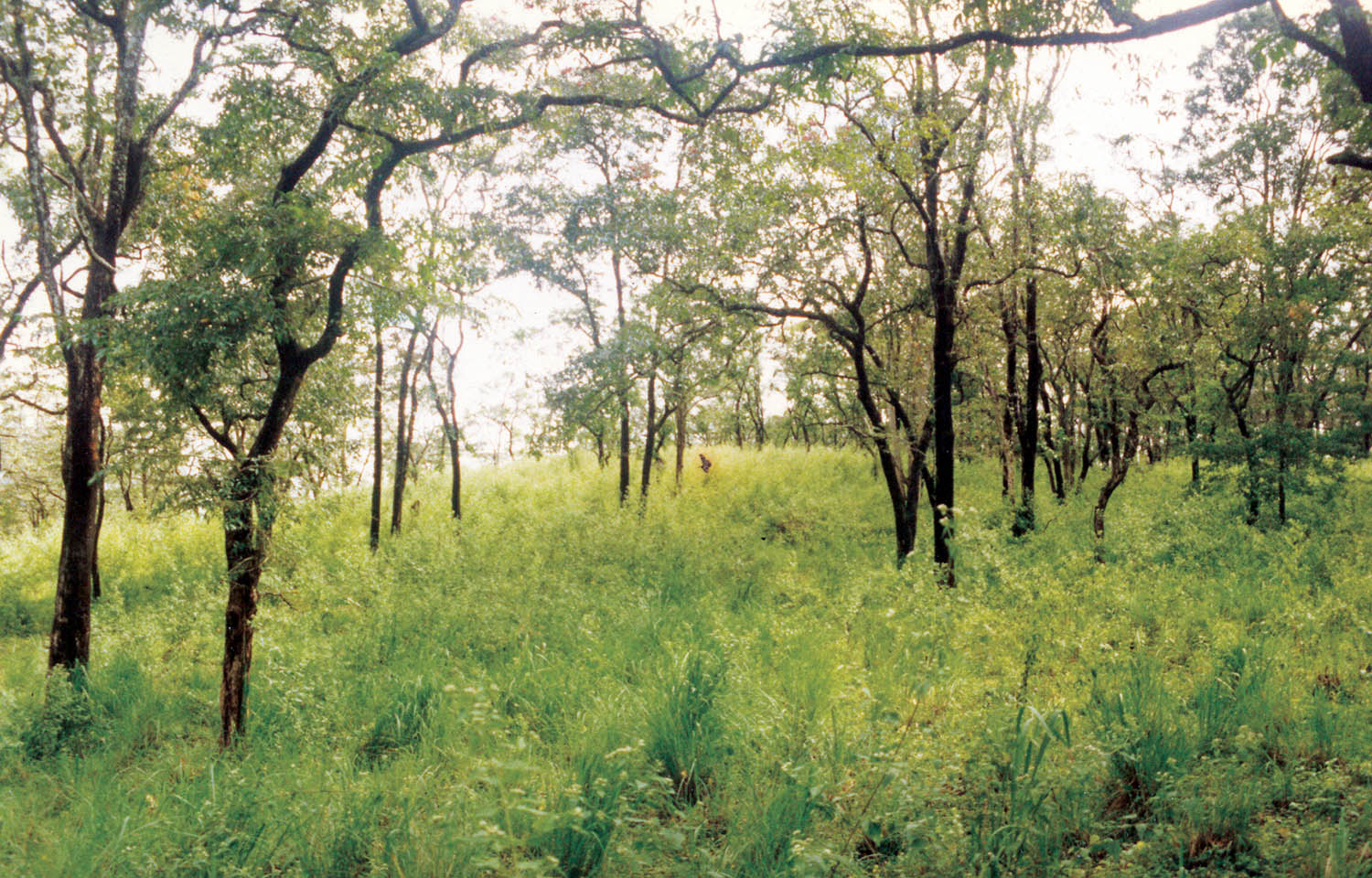
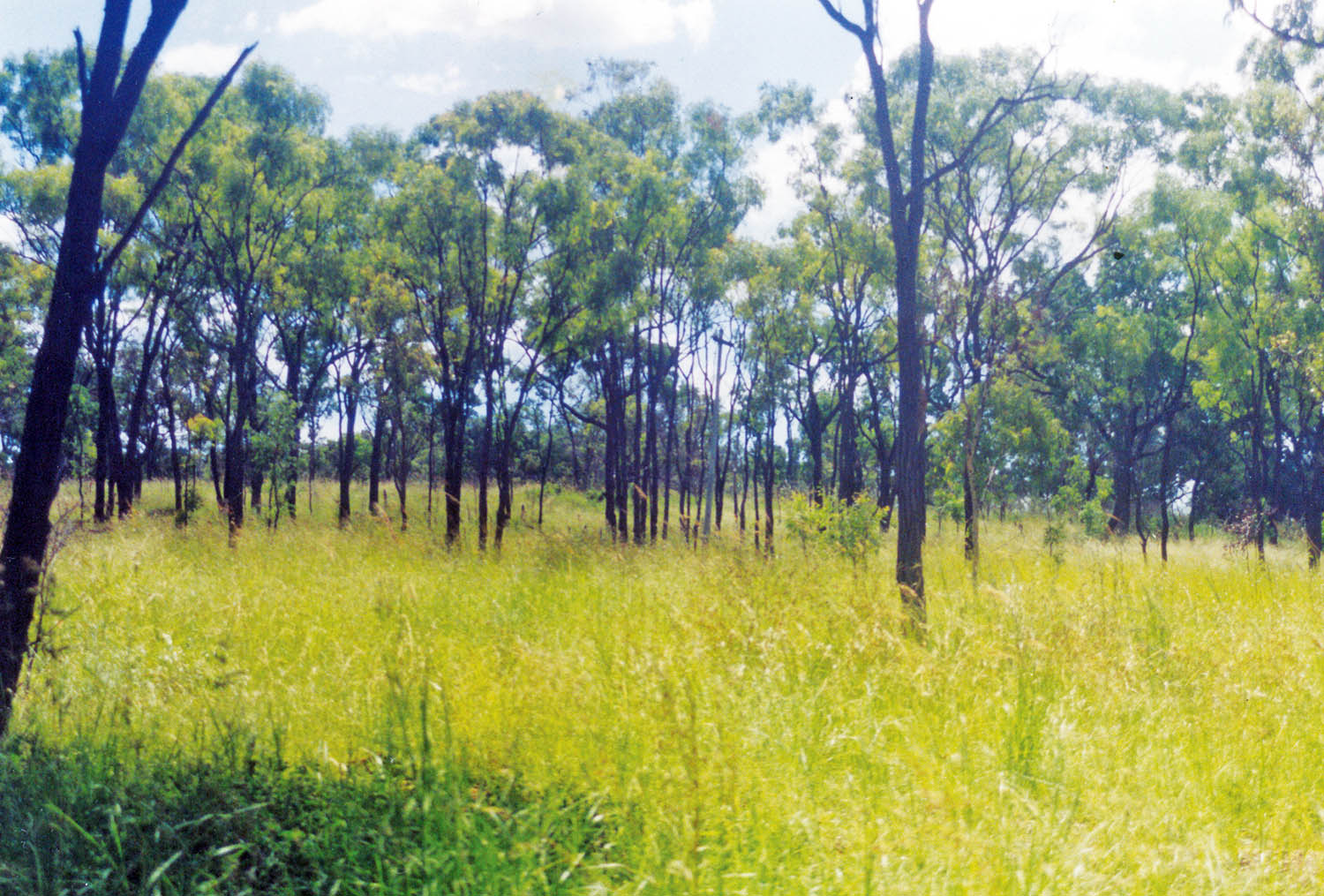
There are many different habitat structures and vegetation types that are within what I define as the "Tropical Woodlands”. The tropical open forest is the common default expression of the dry seasonal tropics on average land in northern Australia. The open canopy is usually dominated by Eucalypts, such as Eucalyptus miniata and E. tetradonta across much of northern Australia. The shrubby understorey can vary but includes various Acacia, Proteaceae species, or even cycads. And of course grasses dominate at the ground level. Savanna and tropical grasslands are the purest definition of 'savanna' at an international level, based mainly on the well known grassland plains of Africa, however these are somewhat modified and opened up by their very large herbivorous mammals and humans. In Australia, these more open tropical grasslands can develop because of different situations, such as exposed and/or low nutrient sandy soils, or seasonally flooded plains. As one travels further south and further inland, the forests get drier, their plant and animal composition changes, and this arid woodland become restricted to gorges and ephemeral waterways.
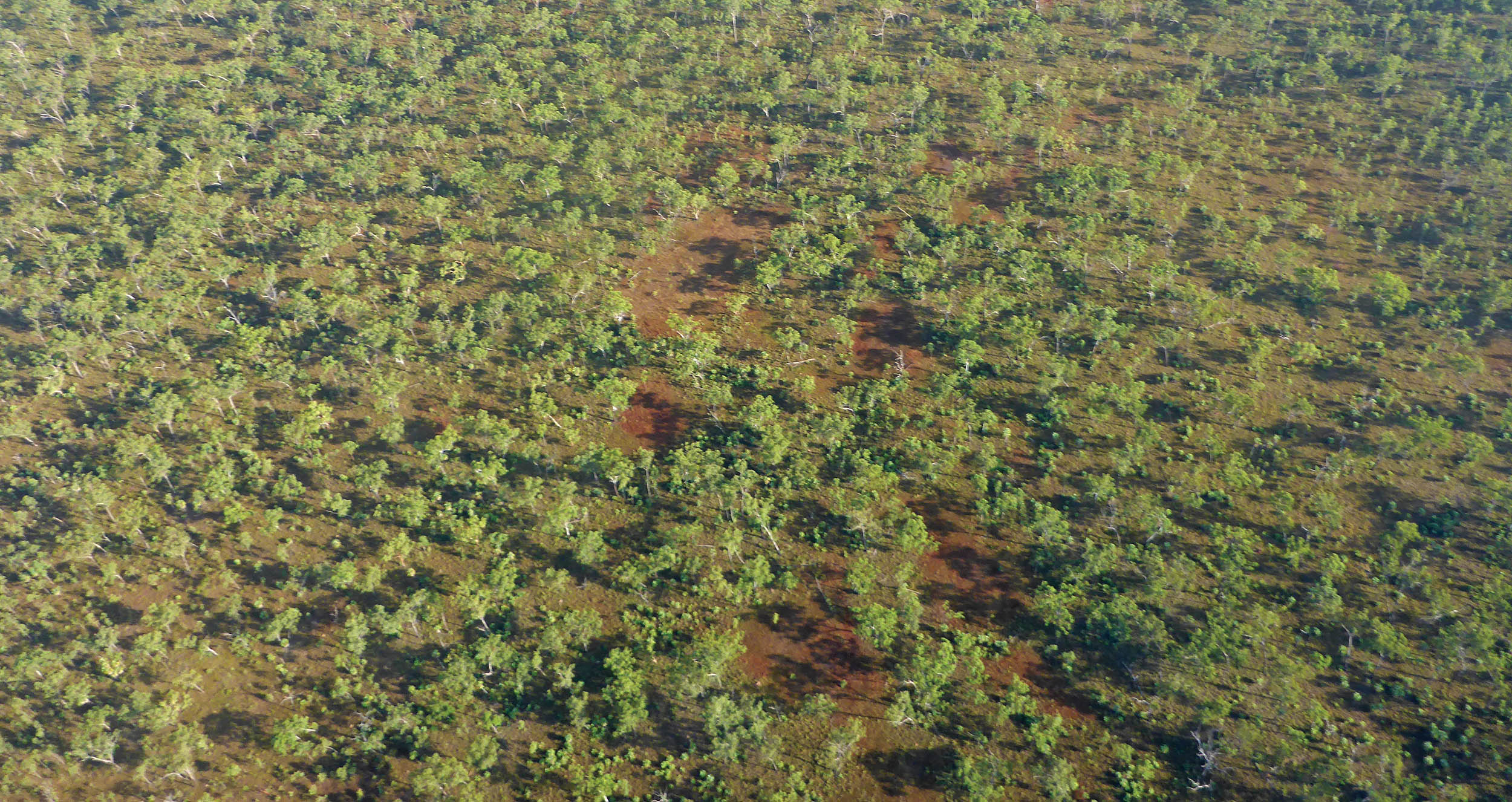
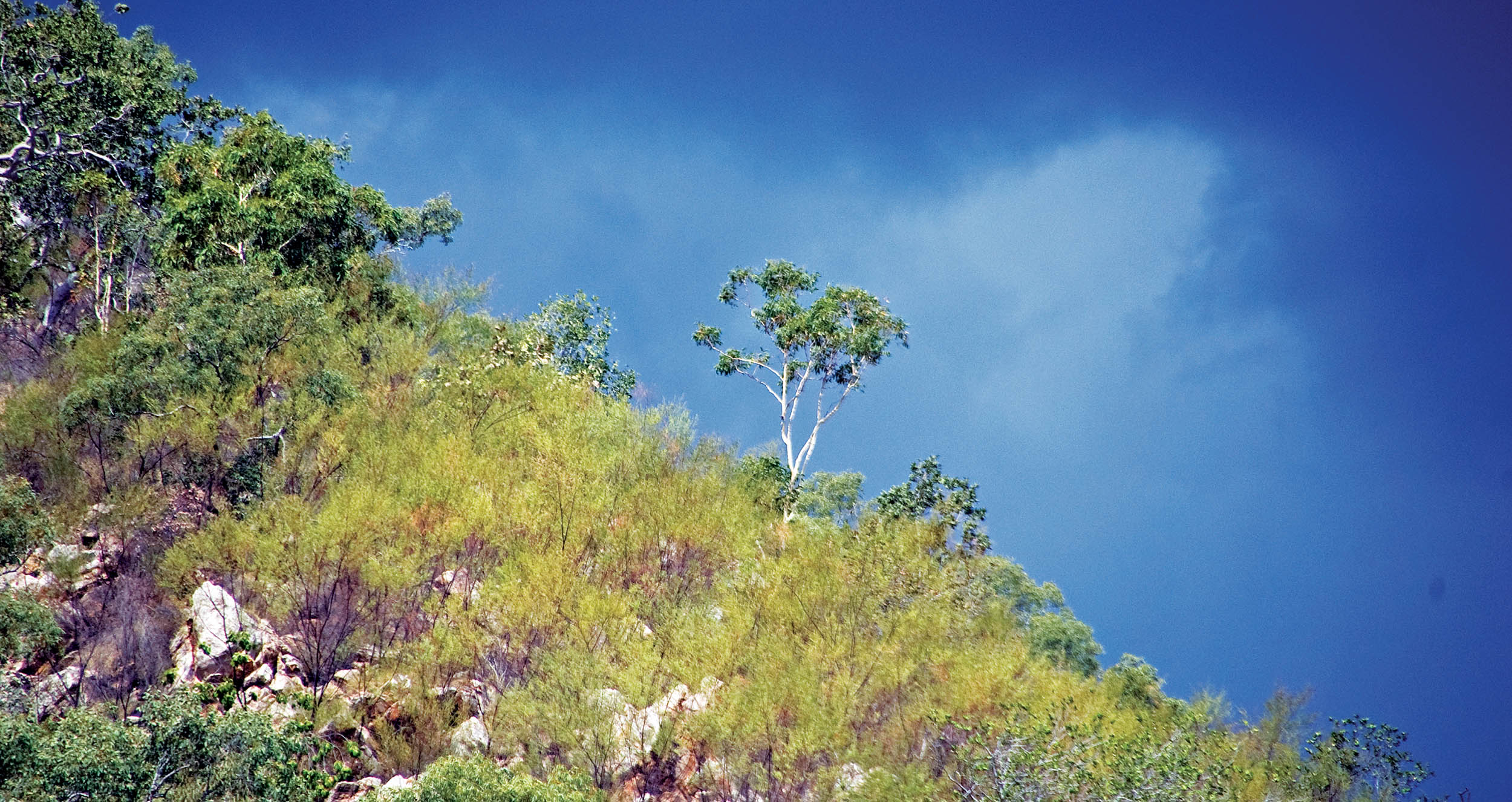
Waterways are the veins of life running through the seasonally dry savanna grasslands and woodlands (below). These beautiful rivers are oasis for humans as well. They are dominated by species such of Melaleuca along their banks, and may also have sections of obviously darker green monsoon rainforest.
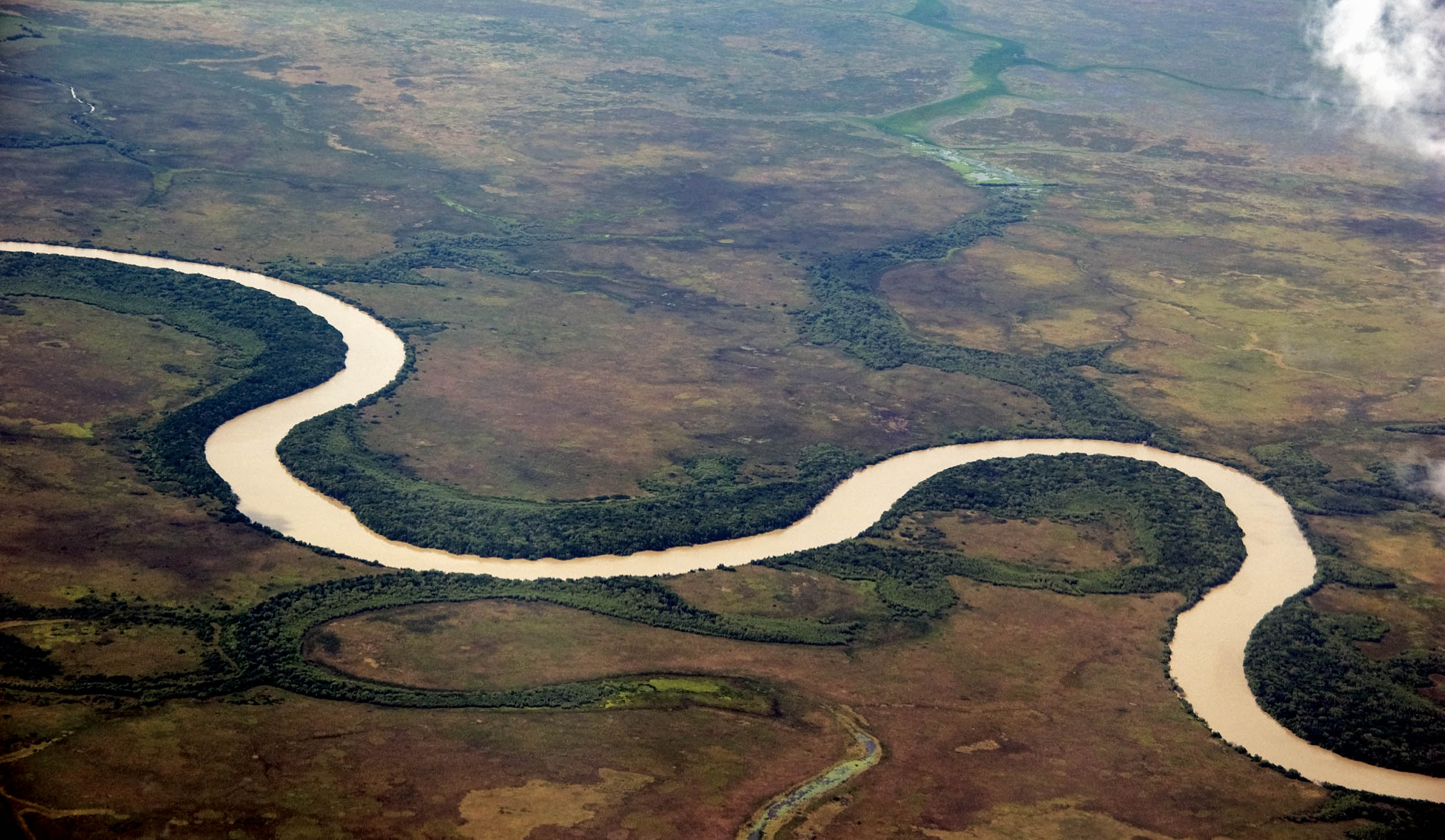
Low lying areas in the seasonal tropics are inundated every wet season. The main trees here are Melaleuca (below left) and Pandanus (below right). During the course of the dry they reduce in size and wildlife may congregate around their shrinking pools. In all seasons, they are the best areas for diversity and number of animals. This habitat is covered in the section on Australasian tropical freshwater wetlands.
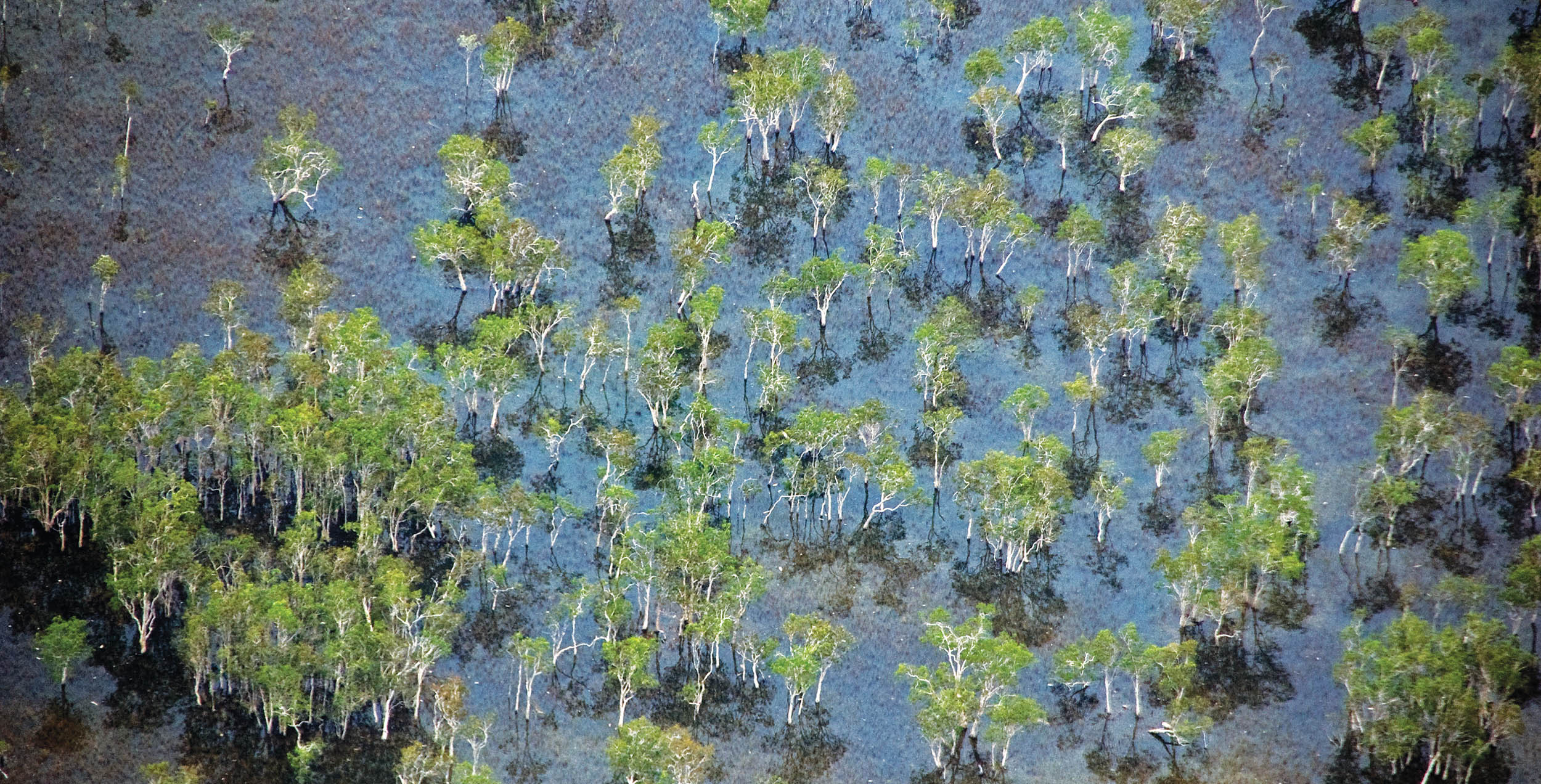
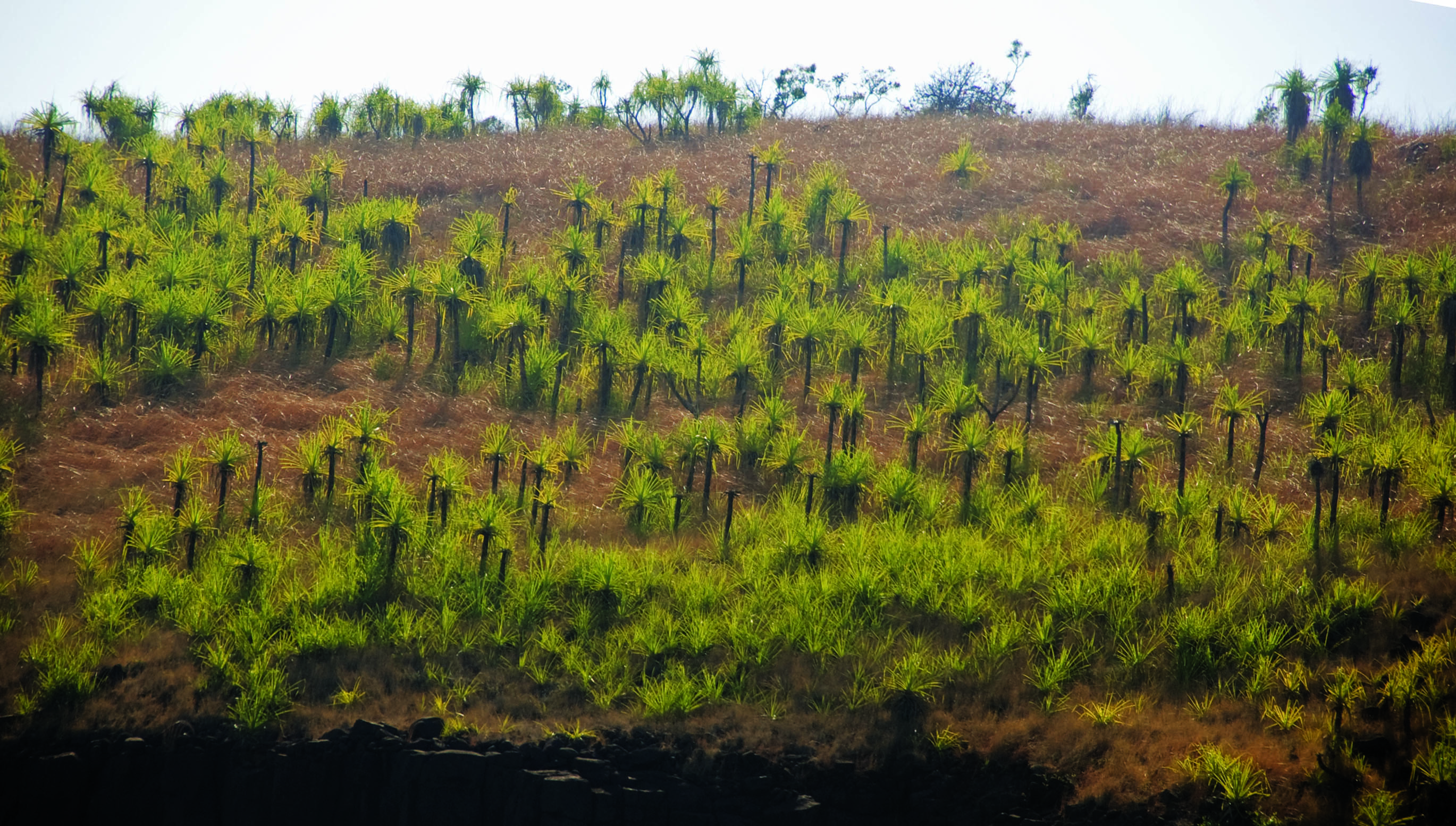
The seasons and their effects are more visually obvious in the tropical savanna than the adjacent tropical rainforests. This is due to the monsoonal rainfall pattern. Most Australians think of only two seasons, a ‘wet’ and a ‘dry, but those people that live in a much more exposed position in the environment, such as the various indigenous folks across northern Australia, recognized many different shorter, but distinctive, seasons. For example in southern Cape York, there were 6 seasons for the Aboriginal Kuku-yalanji people, while in the top end, indigenous people recognised up to 8 distinct seasons.
When the rain falls in the 'wet season' it really falls. Within a relatively short summer monsoon season from December through to April, several metres of rain is dumped on the land. This can often occur in torrential downpours. The drops are literally larger and heavier than temperate rain. Colours start to become saturated with the increased humidity in the air and the generally glistening wetness produced by rain. The 'cool dry season' dominates much of the year across northern Australia. It may not rain for months. The nights are cooler. Many Australians don’t think there are native deciduous tees in their country, however there are several that are winter deciduous, losing their leaves in the dry season. This allows easier advertising and access of flowers and fruit to animals. But it is mainly for reducing water loss.
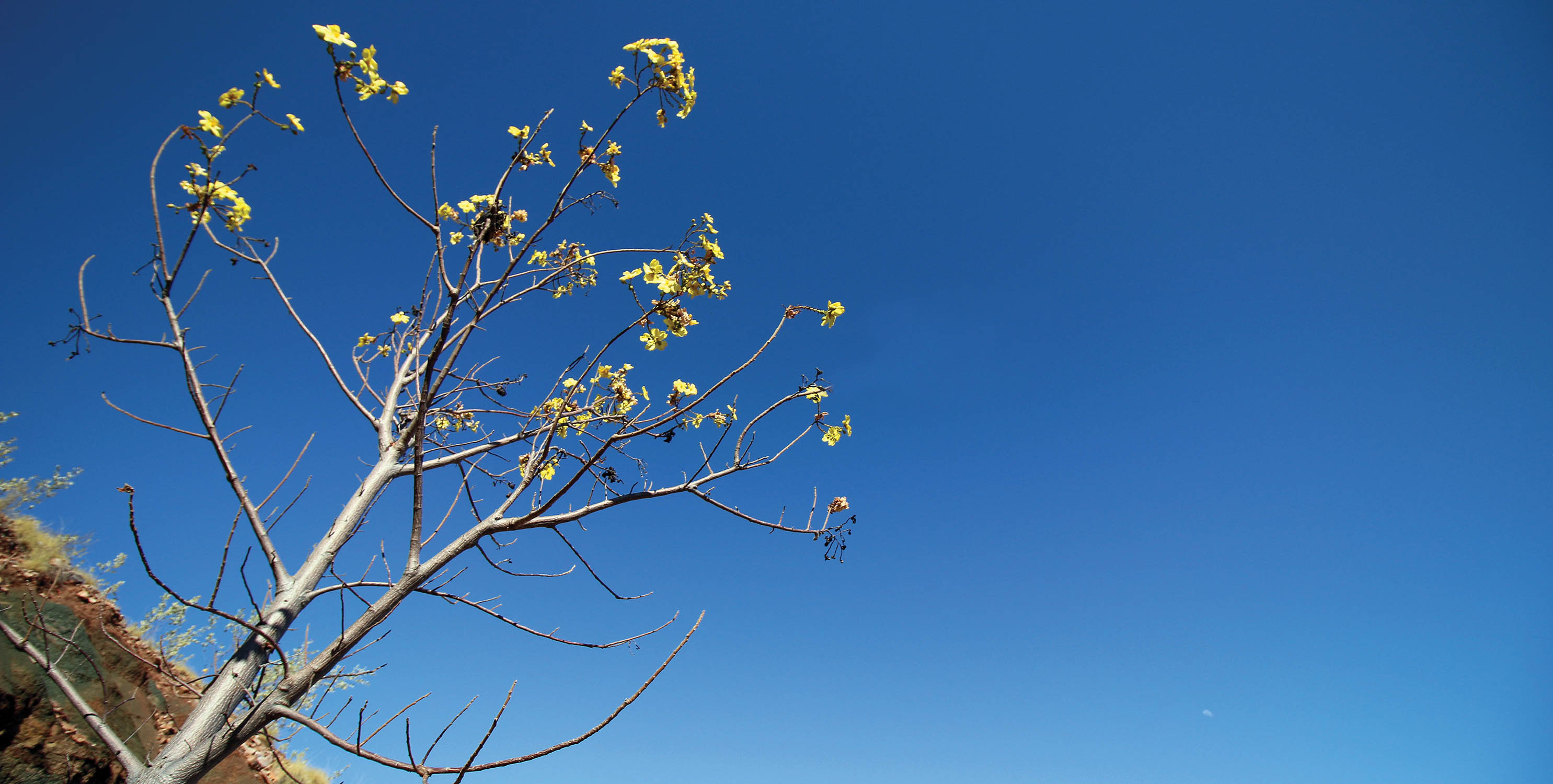 (the flowers of Kapok show in the dry season when the tree has dropped it's leaves)
(the flowers of Kapok show in the dry season when the tree has dropped it's leaves)In the late dry season. Fires can occur at any time of the dry season. But there is a tendency for them to naturally occur well into the dry season, when things are at their most parched. The fires in the north of Australia are very different from those in the southern parts of the continent. They are merely ‘grass fires’ (below) compared to the sometimes explosive crown fires in the temperate regions.
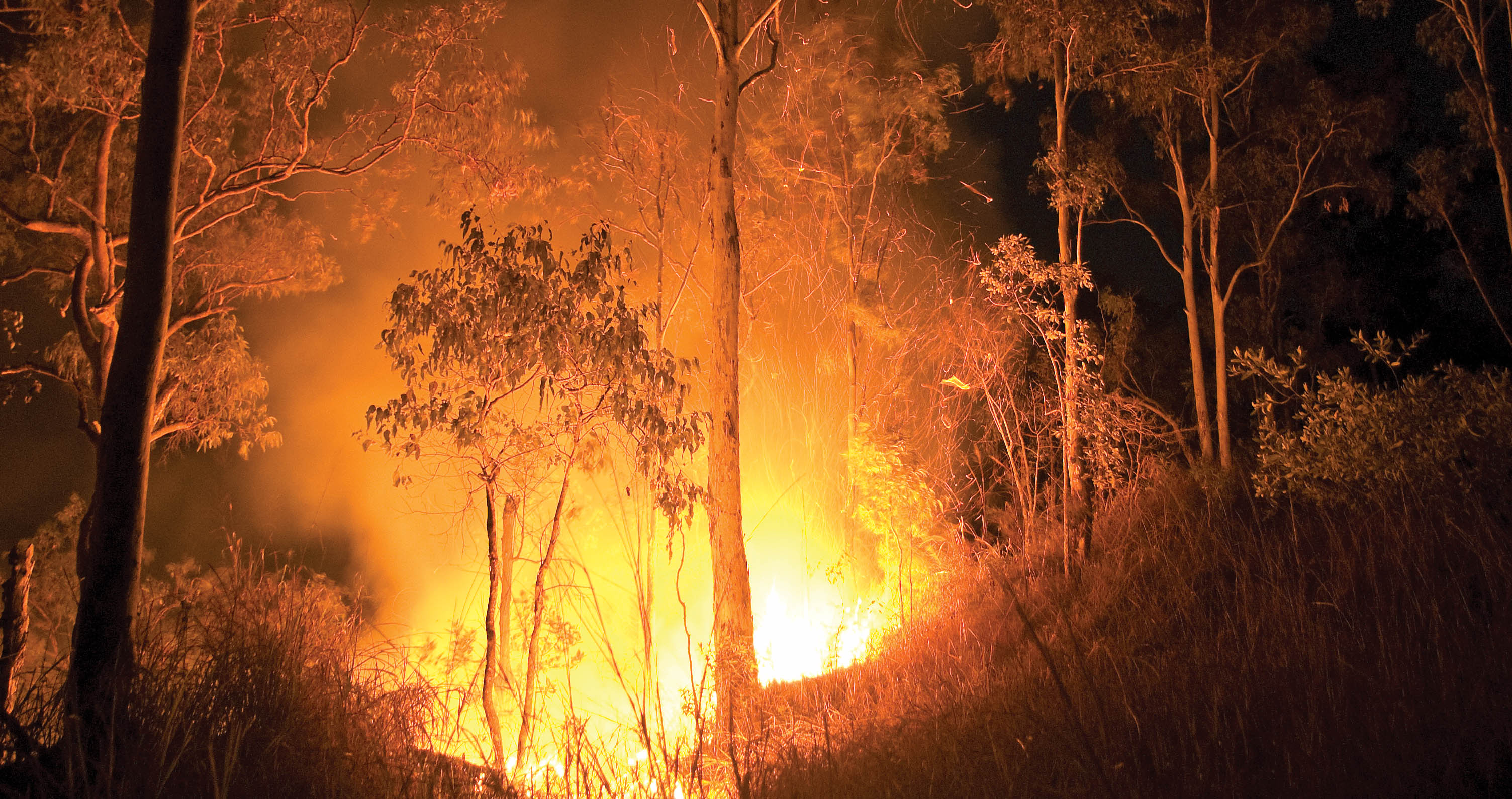 (Gilles Range, Queensland)
(Gilles Range, Queensland)The ‘build up’ is the time leading into the wet season. The temperature starts to increase, but it is not yet raining regularly. There are often large dark clouds on the horizon. Rain threatens to spill out from the sky, but does not. The increasing humidity is oppressive. This promise of rain but no delivery frustrates people, and the build up is often thought of as a time of ‘craziness’. (And this is in the northern parts of Australia where we are not considered the most normal of people to begin with!) Long time residents are looking forward to the wet season. When the heavens finally open up, it is like going to the toilet after having to hold it in. For six months.
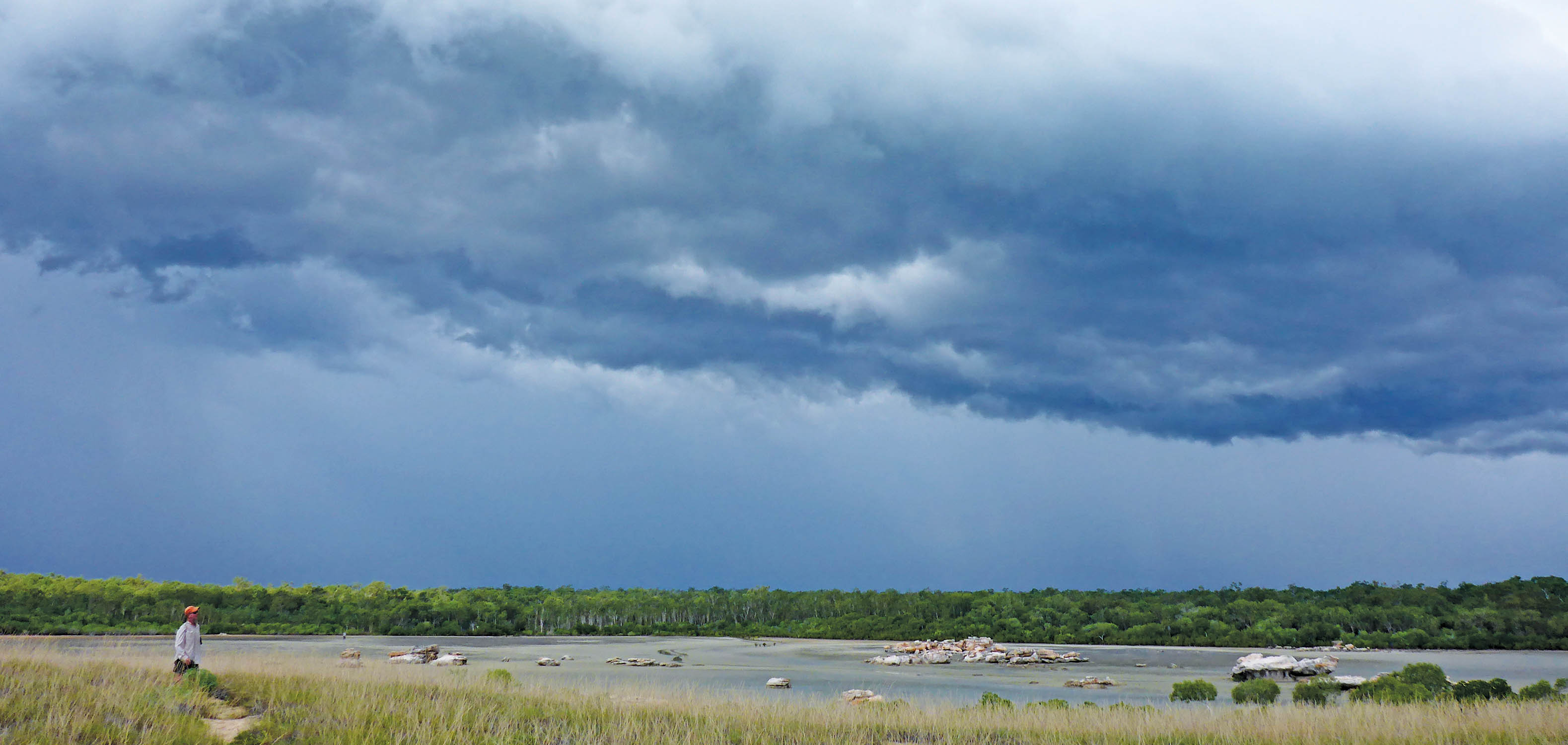
The first rains usually fall before Christmas. They offer relief both to people dealing with the increasing heat, but also to plants. At this time, small bright green blades of grass begin to erupt from the sparse ground cover (below), which is often black from previous fires. And thus begins the wet season and we have cycled back again
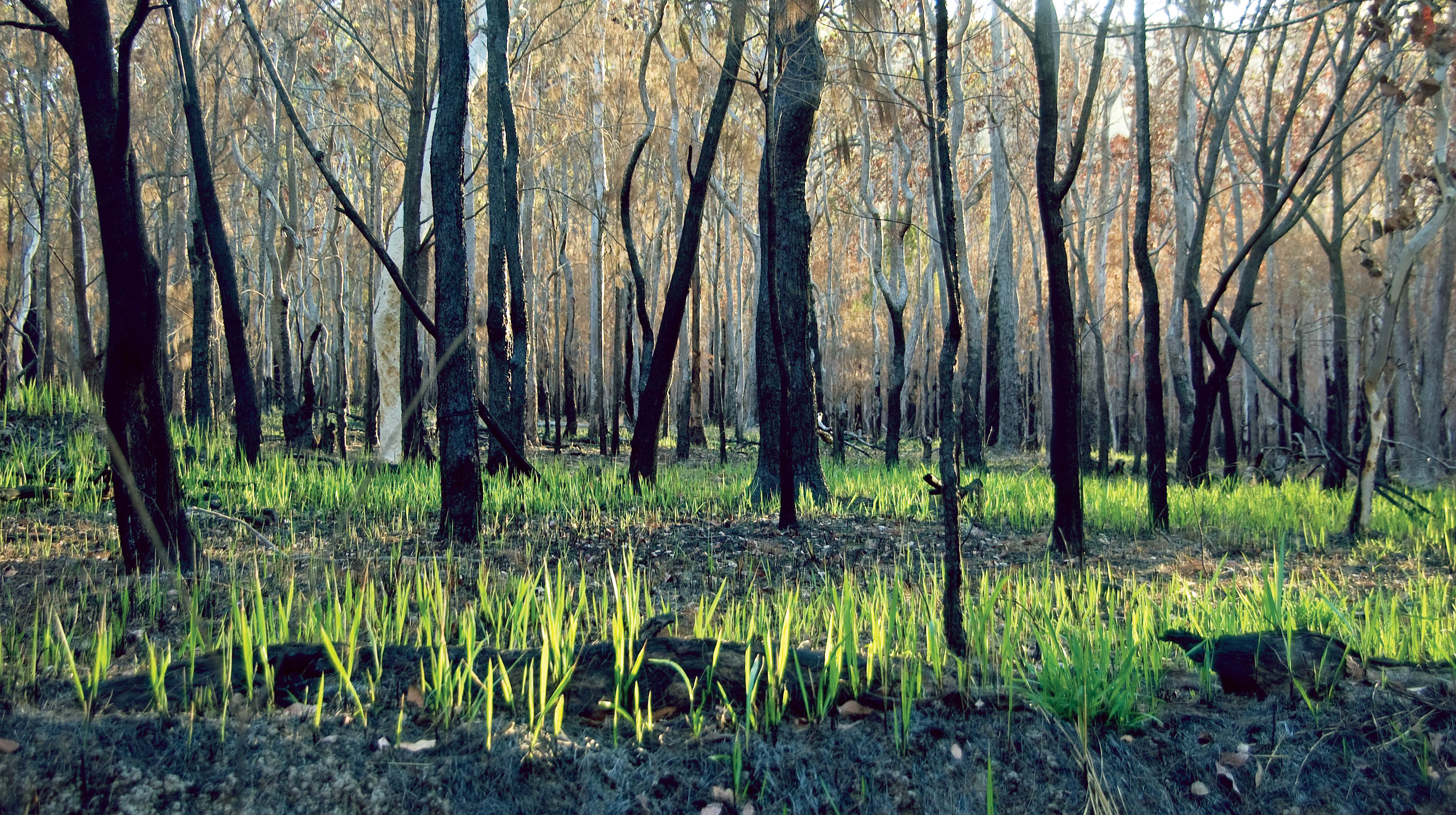
The Baobab genus Adansonia is centred mainly in Madagascar, where there are 7 species. There are only another three species found outside this large island. One of them is Adansonia gregorii, 'Australan Boab', which is endemic to the north-west of Australia. It has a distinctive fat trunk and leaf-less dry season branches.
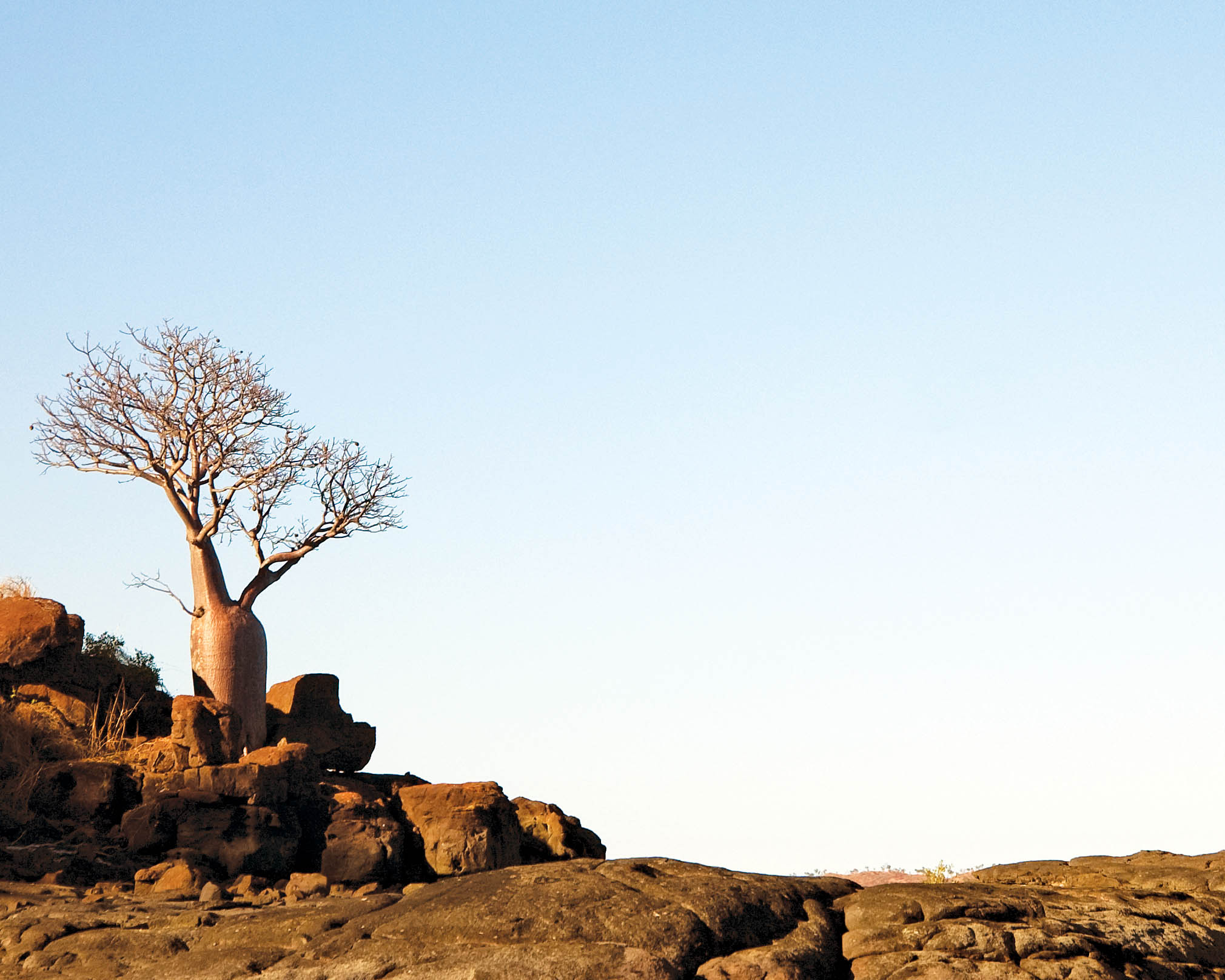 (Sheep Island, Camden Harbour, WA)
(Sheep Island, Camden Harbour, WA)The fruit of an Australian Boab tree (below) has edible stiff flesh which I describe the stiff flesh as 'lemony styrofoam'.
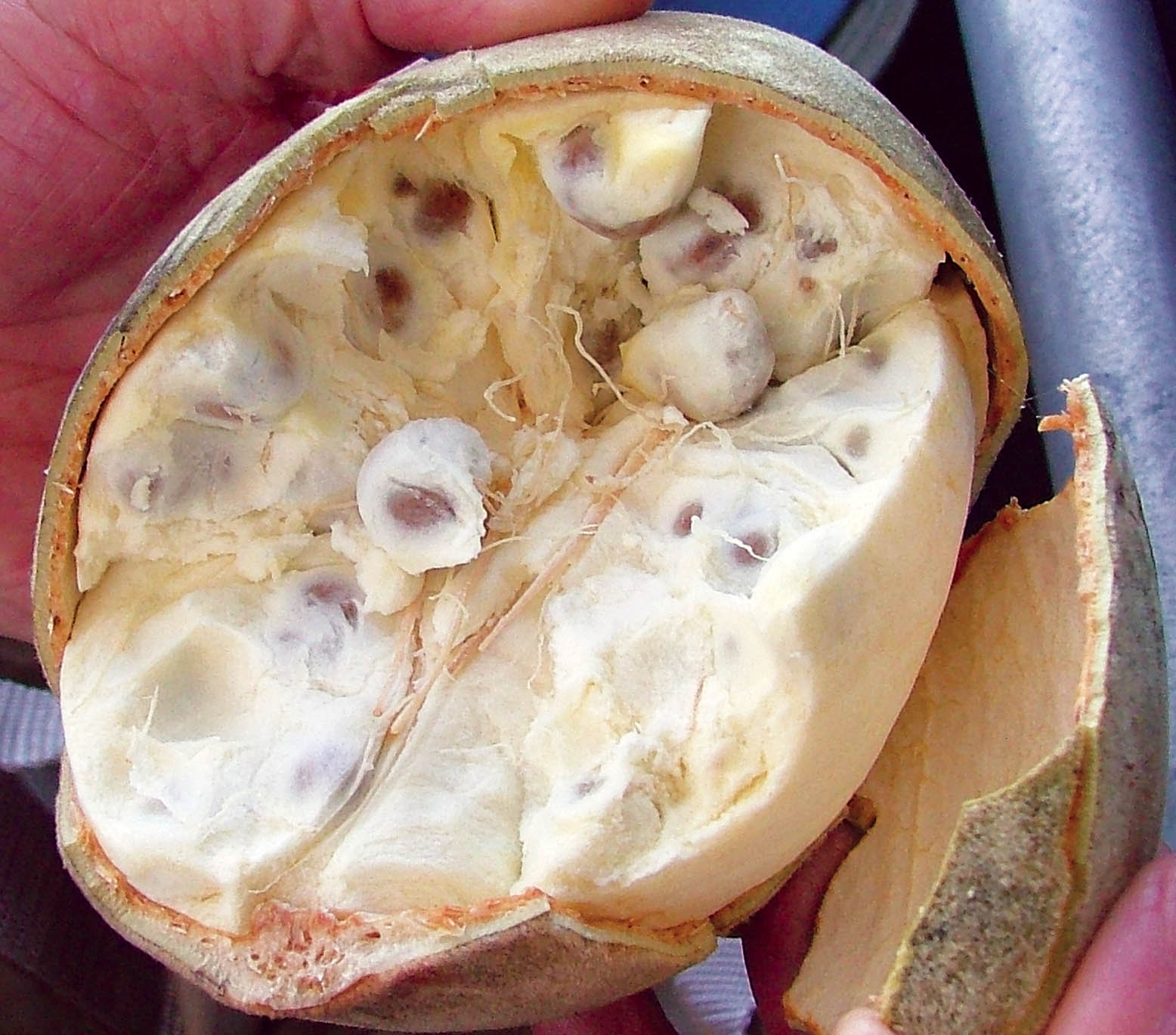
The family Bixaceae/Cochlospermaceae contains the genus Cochlopsermum found in the many of the dry tropical areas across the world. They mostly have large bright yellow flowers followed by large baseball fruits full of soft hairs that wind distribute the seeds. The tropical woodlands of northern Australia has three species. They are commonly noticed due to the flowers appearing in the dry season when the leaves have dropped. On the east coast is Cochlospermum gillivraei (below).
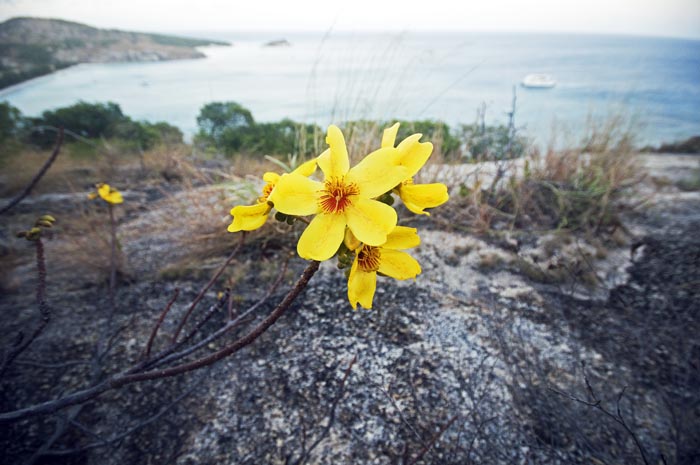
The cotton family Malvaceae includes the genus Sterculia which is found throughout the tropics of the world. The most common species in Australia are known as 'peanut trees' as their small black seeds (normally hanging down from the edge of the bright red hard fruit shell above) taste delicious, and indeed like peanuts.
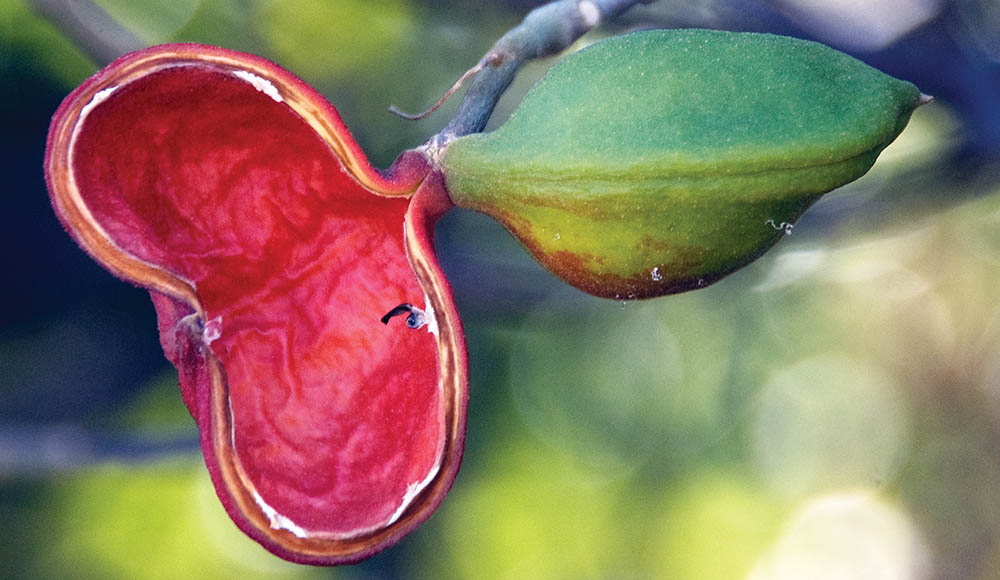 (Kimberley, Western Australia)
(Kimberley, Western Australia)Also in this family are the Bottle Trees, which look similar to Boabs, are often confused. Brachychiton rupetris, 'Queensland Bottle Tree' (below). Like the Boab, they also have a swollen trunk and are leafless in winter.
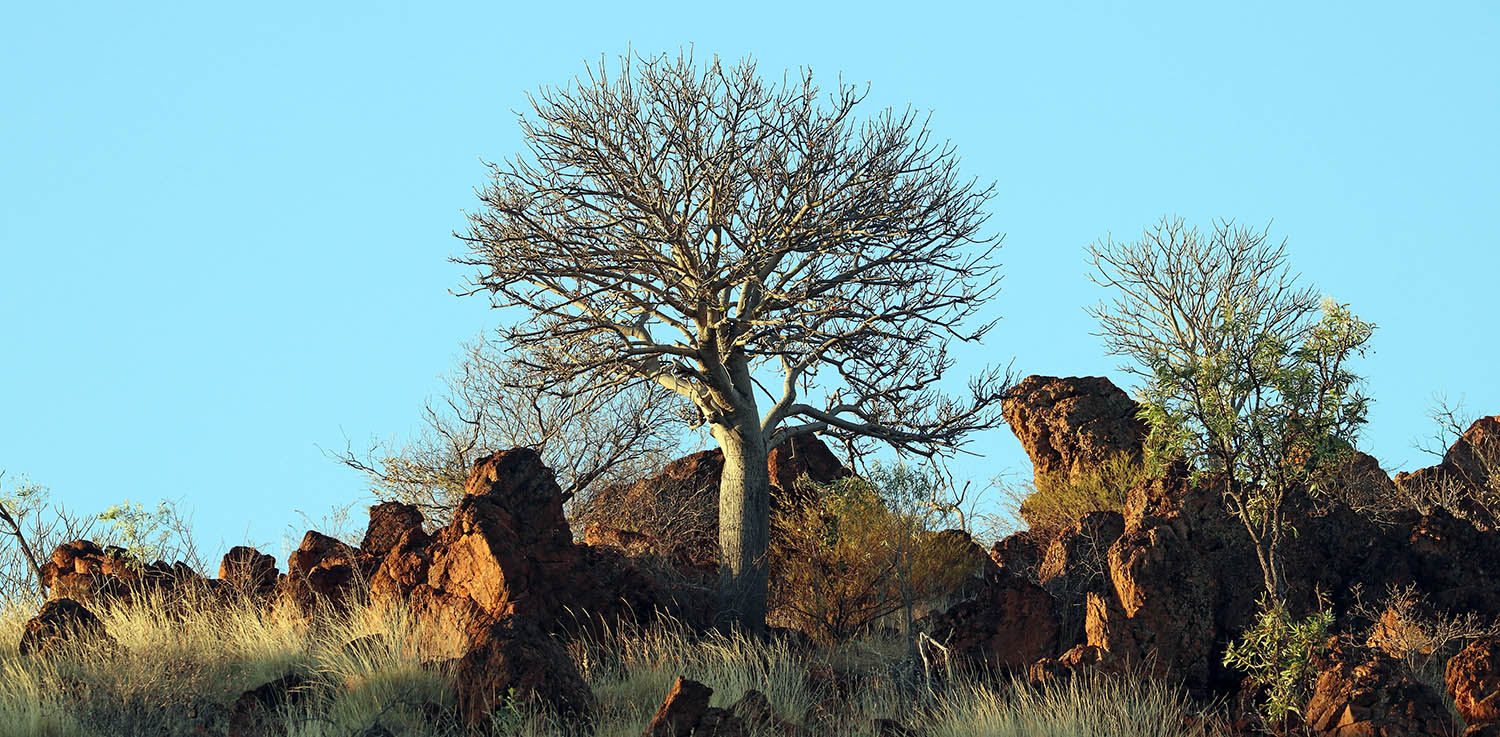 (Clem Walton Lake, Queensland)
(Clem Walton Lake, Queensland)The family Myrtaceae is arguably the most important on the Australian continent, and are common and dominant in the woodlands. The most useful diagnostic feature of this family are the leaves and their obvious oil glands, which may appear as light dots when the leaves of certain species are held up against bright light. The flowers in the Myrtaceae family are usually quite showy, but not in the usual way; instead of colourful petals, there is instead a seemingly unlimited number of stamens, giving the flower the appearance of a brush.
There are about 50 species in the genus Durabaculum, the 'Antler Orchids'. They are found throughout tropical Asia and the islands of the south-west Pacific. They were recently split from Dendrobium. The plants are usually made up of large stalks with thick leaves. The flowers are frequently large and colourful, and often have wavy or twisted petals. The flowers also live longer than most orchid flowers, and are mostly pollinated by large wasps. They are generally long lived and hardy for an orchid, and thus include some species that can handle and grow on the tropical woodlands on island ridges exposed to the salt of the tropical coast. The most common species in the tropical woodlands of the east coast is Durabaculum undulatum (previously Dendrobium discolor) 'Golden Antelope Orchid'. They are epiphytic, including in mangrove trees, but more commonly growing as a lithophyte (including on rocks). The stems may stretch out for a metre. Flowers vary in colour depending on variety, but usually gold. They grows in rainforest, mangroves, and tropical open forest, mainly in coastal situations, from central Queensland up into New Guinea. Because of its hardiness, they are popular in tropical gardens.
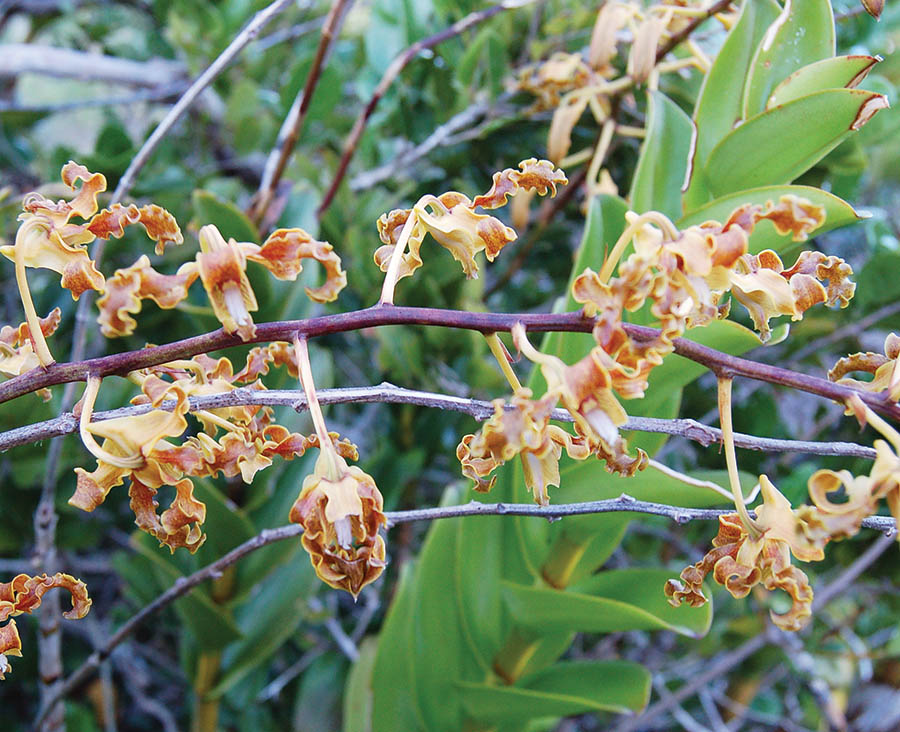 (Lizard Island)
(Lizard Island)The coffee family Rubiaceae includes Morinda 'Cheesefruit'. Also in this family is Morinda reticulata, 'Mapoon', 'Ada-A Morinda', or 'Yellow Dye', now known as Coelospermum decipiens. It is a small shrub with small white flowers but large and striking white leaves. It is apparently grown in gardens in North America, but not commonly in it's native country of Australia.
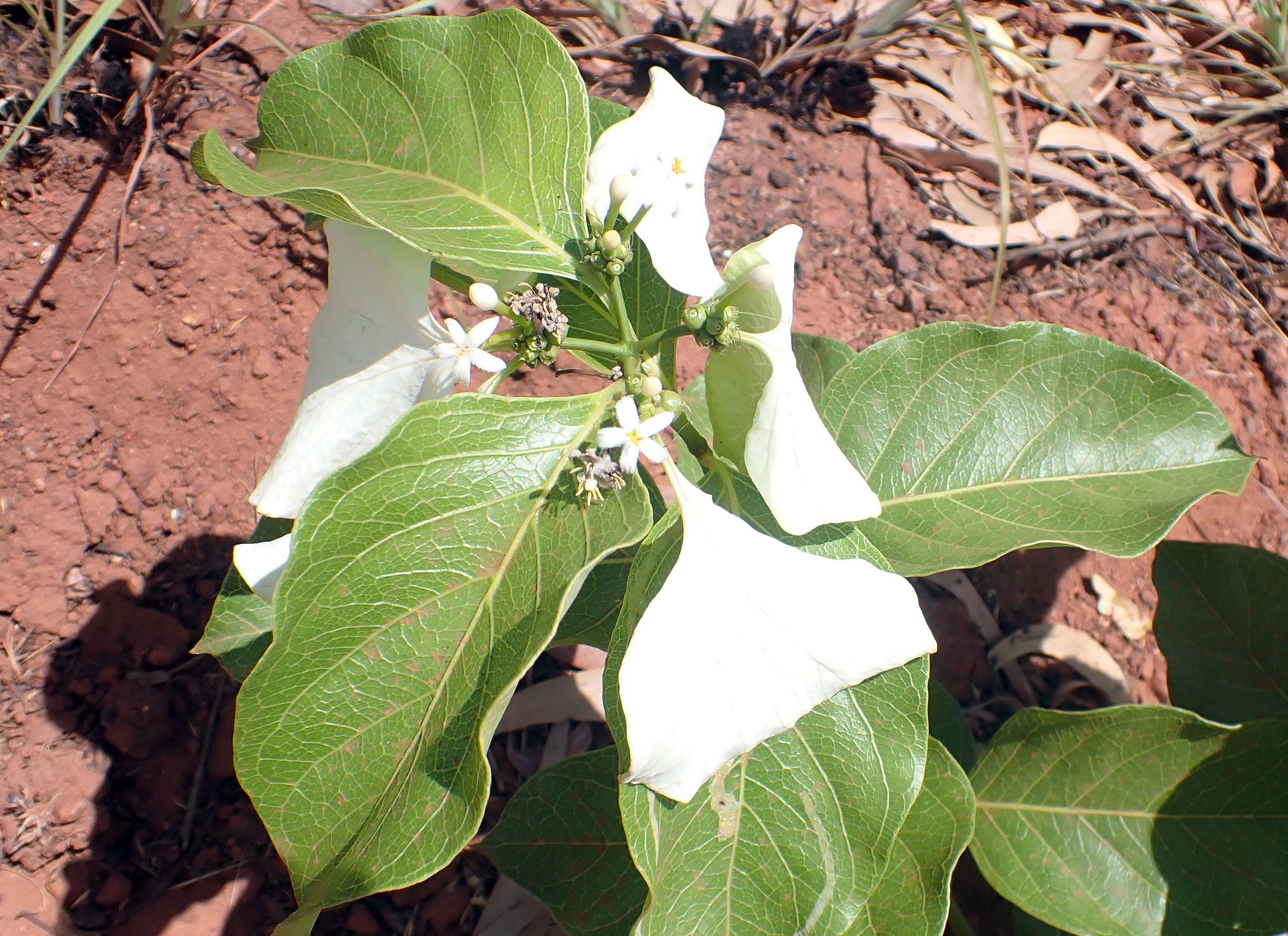 (Mutee Head, Cape York, Queensland)
(Mutee Head, Cape York, Queensland)The order Blattodea contains all the 'Cockroaches'; where most people are familiar with the introduced house pests, there is a large variety of native species.
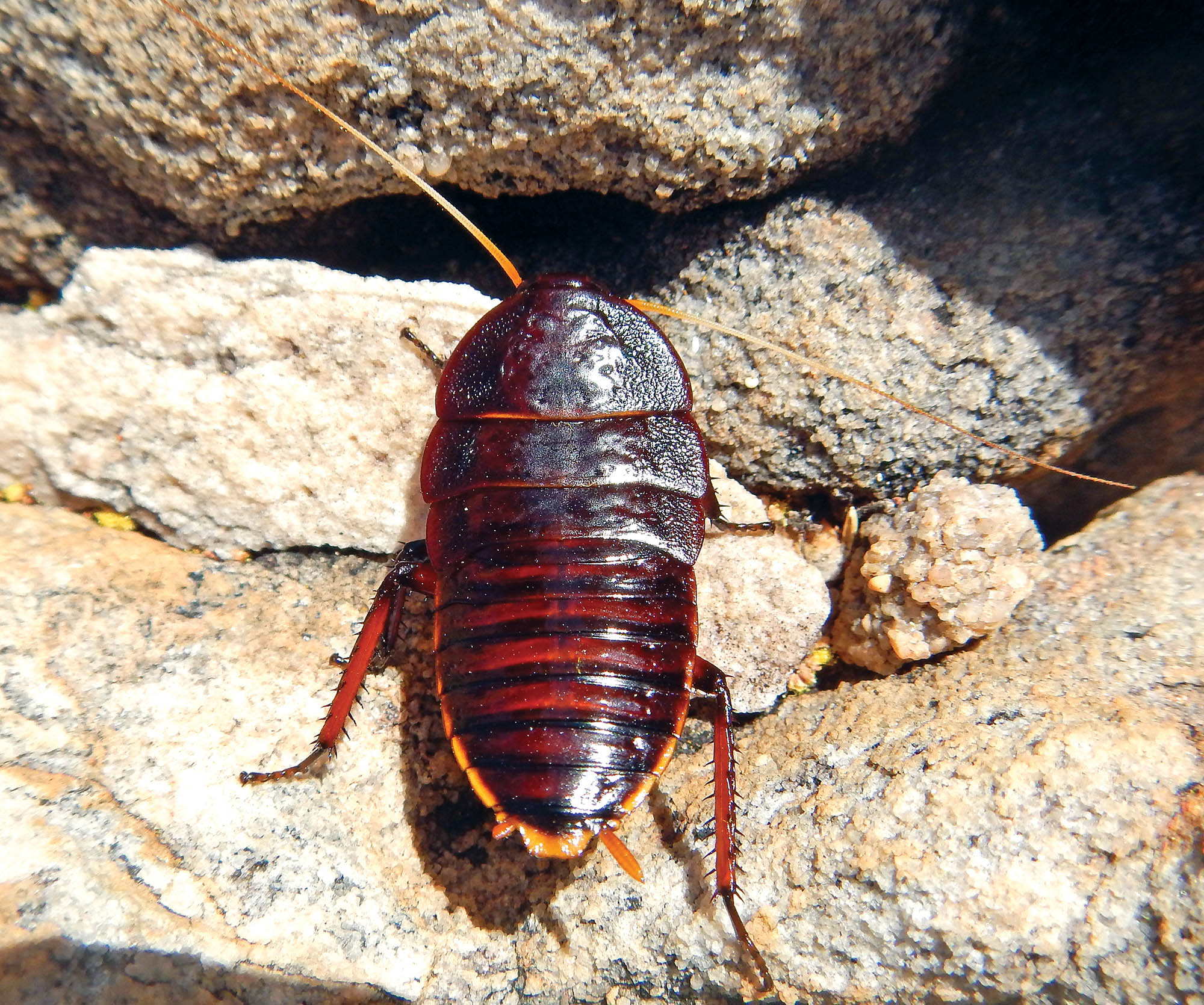 Megazosteria sp. 'Bush Cockroach'.
Megazosteria sp. 'Bush Cockroach'.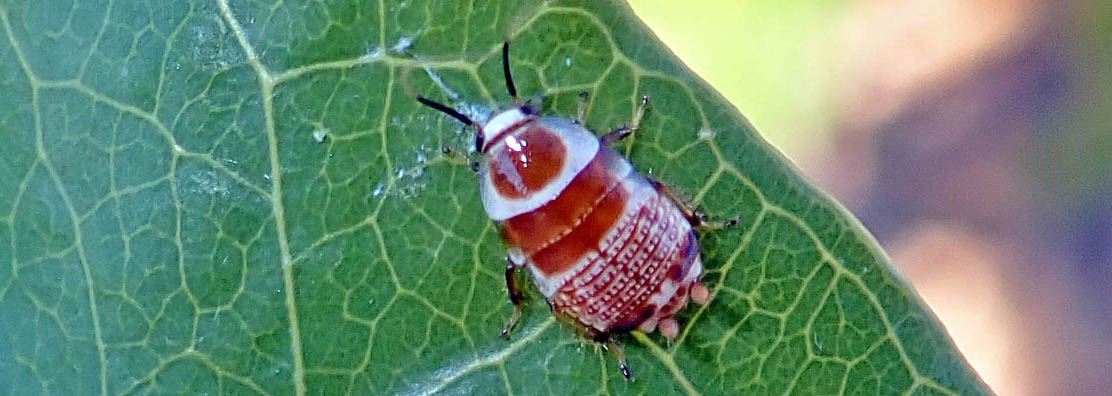 Ellipsidion sp., (Swift Bay, W.A)
Ellipsidion sp., (Swift Bay, W.A)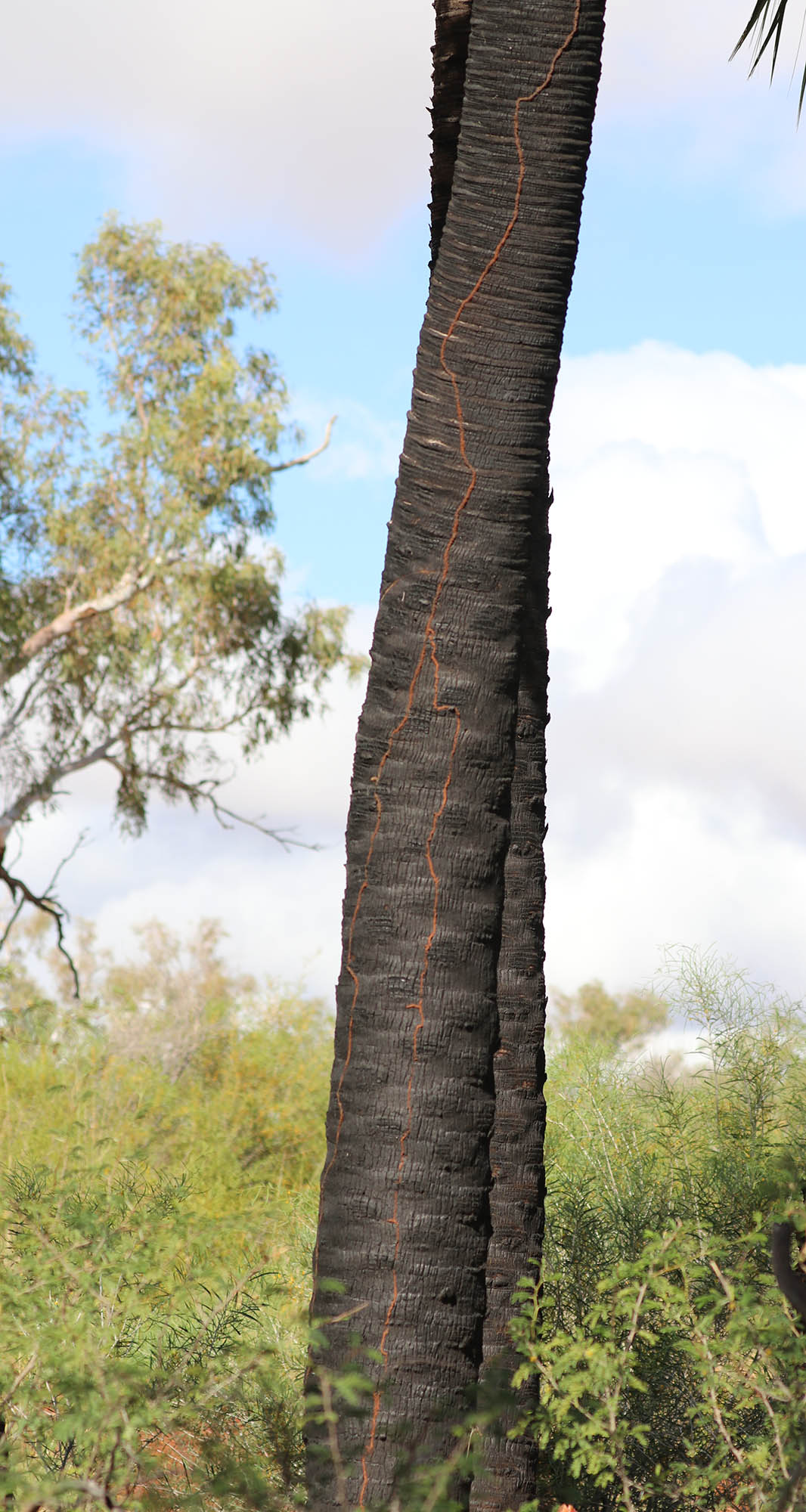 (Millstream Chichester National Park)
(Millstream Chichester National Park)While termites are often called ‘white ants’ and do superficially resemble ants, they are in fact not at all closely related. Their order Isoptera is considered much more primitive than ants, but they have evolved a complex colonial caste system similar in some respects to ants, with specialized ‘worker’ and ‘soldier’ individuals. Termites feed primarily on cellulose in dead vegetation and are thus acknowledged to be important recyclers in the tropical open woodland. They seem even more dominant in the tropical woodlands of northern Australia compared to the equivalent habitats elsewhere in the world. Termites are quite inoffensive creatures to larger animals like humans. They are relatively delicate and are rarely seen on the open ground, with most living within the soil or vegetation. Relatively few species construct mounds, but the species that do are usually the most noticed. Many species travel across the land through specially constructed tunnels. They are usually made up of grains of soil, and stuck together with termite saliva. They can make nice patterns across rock walls and burnt tree trunks.
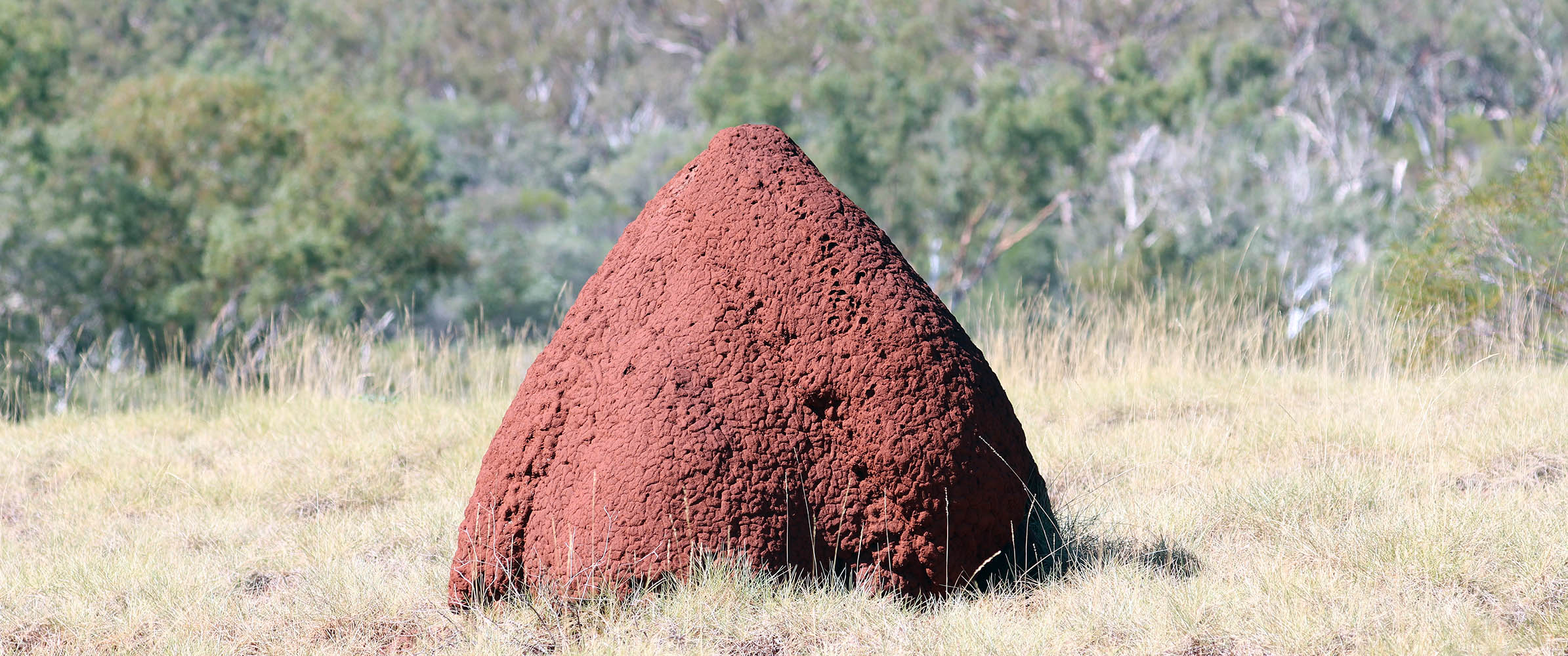 (Millstream Chichester National Park)
(Millstream Chichester National Park)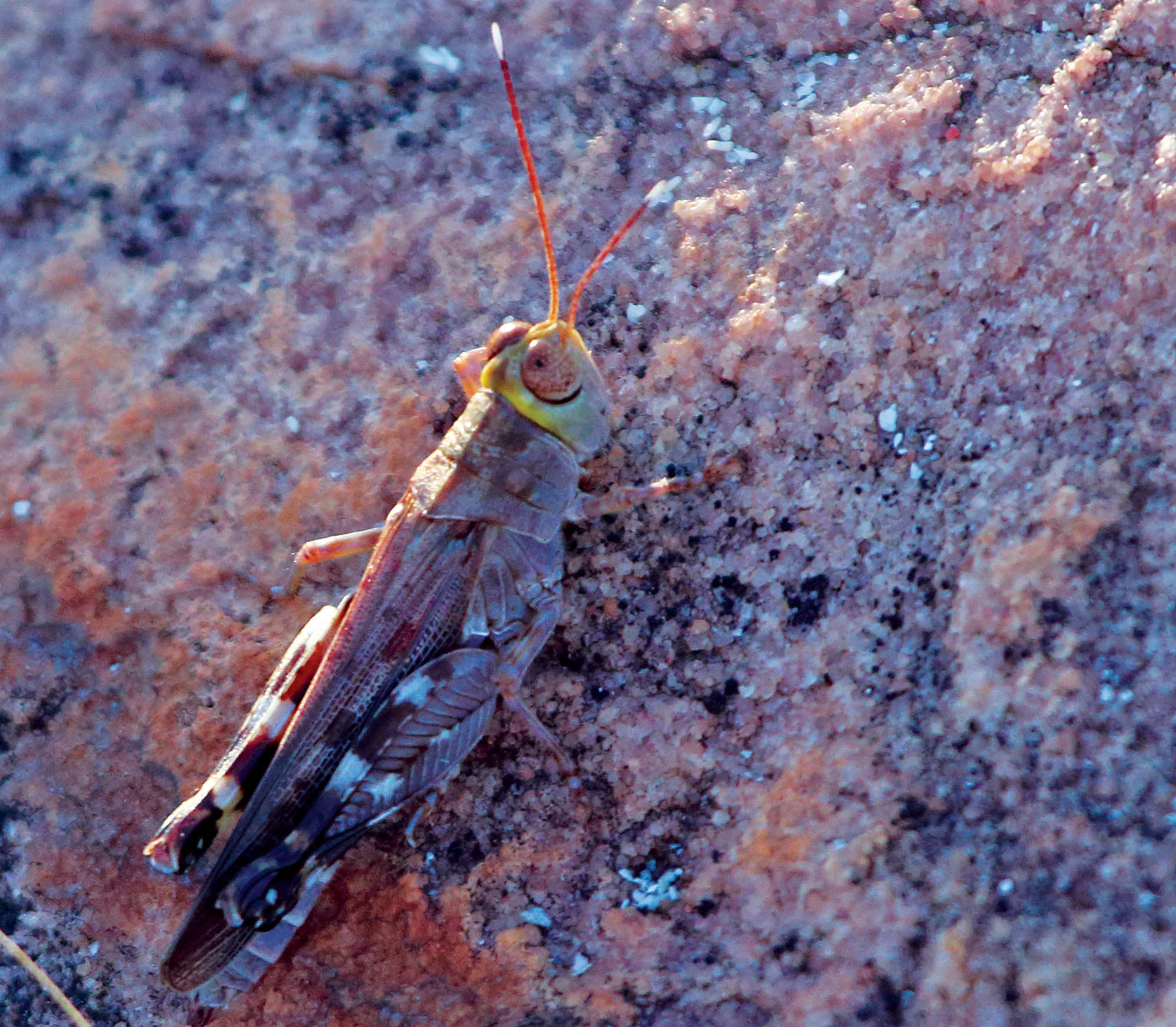 (Jar Island, W.A)
(Jar Island, W.A)The insects of the order Orthoptera are the Crickets, Grasshoppers and Katydids. They are well known for their quick springing and jumping abilities, a skill possible due to the incredibly long legs that are bent back and to the side of the body. This is also a group of ecological and economic importance, as they constitute some of the most dominant grazers in many ecosystems including tropical woodlands, and are among the more serious crop pests around the world. Generally, the crickets tend to be nocturnal, have long antennae and females have an extension to the back of their body which is stuck into soil to lay eggs (ovipositor). In contrast, grasshoppers (pictured right) tend to be diurnal, have short antennae and females lack the ovipositor. Generally, the nocturnal crickets are duller coloured, while the diurnal grasshoppers can be brighter colours. Usually.
The family Acrididae includes the 'Short-eared Grasshoppers' and locusts, and it is the biggest family of grasshoppers, including over 10,000 species (of the 11,000 or so species of the Grasshopper suborder). They are the most common species you see flicking around on rocks in the tropical woodlands. They are usually small and stubby, with short antennae.
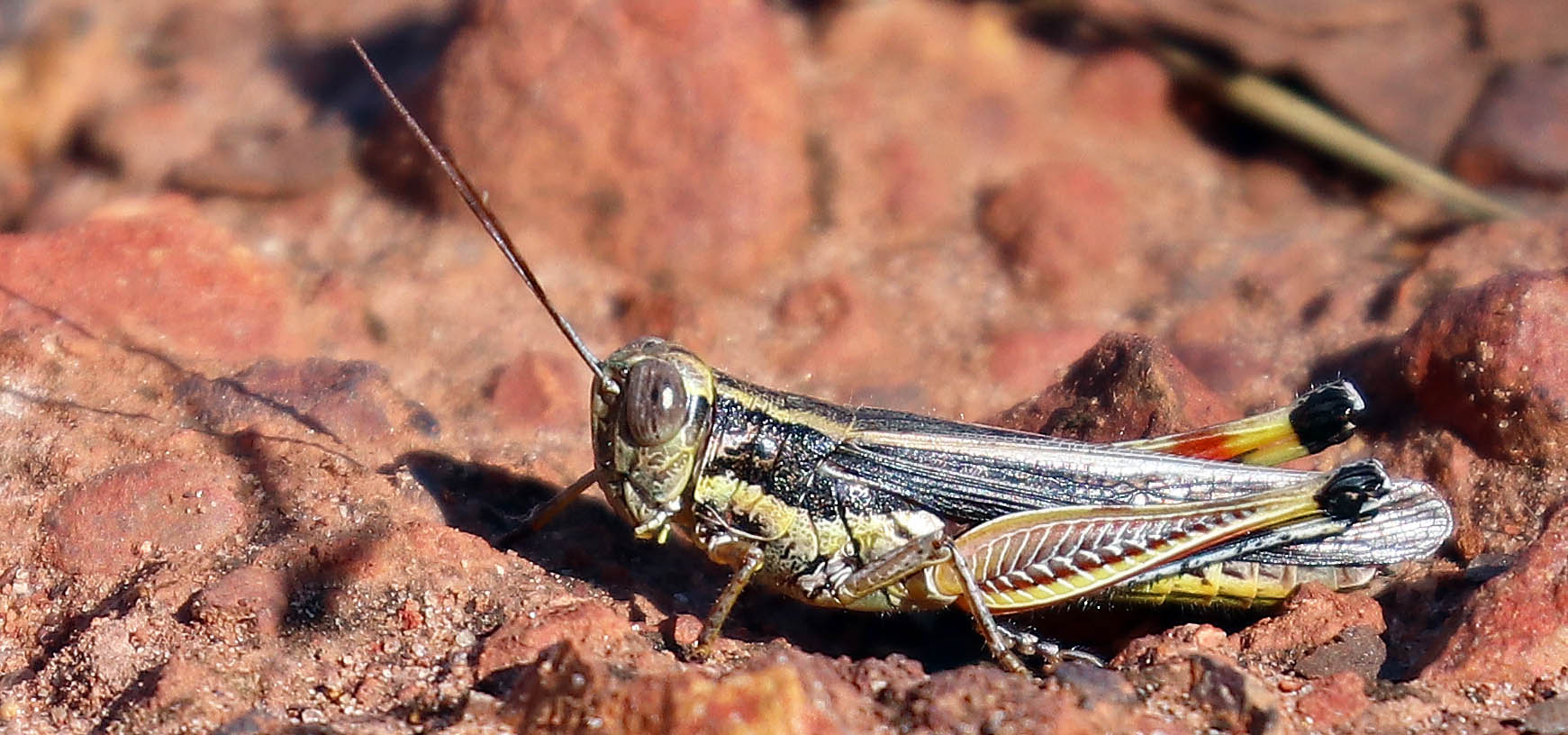
The family Gyrinidae includes hundreds of species of ‘Whirligig’ Beetles. They are often noticed found whirling about in circles on the surface of the quieter waters all around the world. They are in fact looking for dead insects or ones that are trapped in the surface tension of the water. Their eyes are like bifocals, divided into two segments for looking above the water and below the surface simultaneously.
 (Davies Creek, Queensland)
(Davies Creek, Queensland)The order Lepidoptera of the Moths and Butterflies includes a variety of forms. The unusual family Psychidae are the 'Bag Case Moths'.
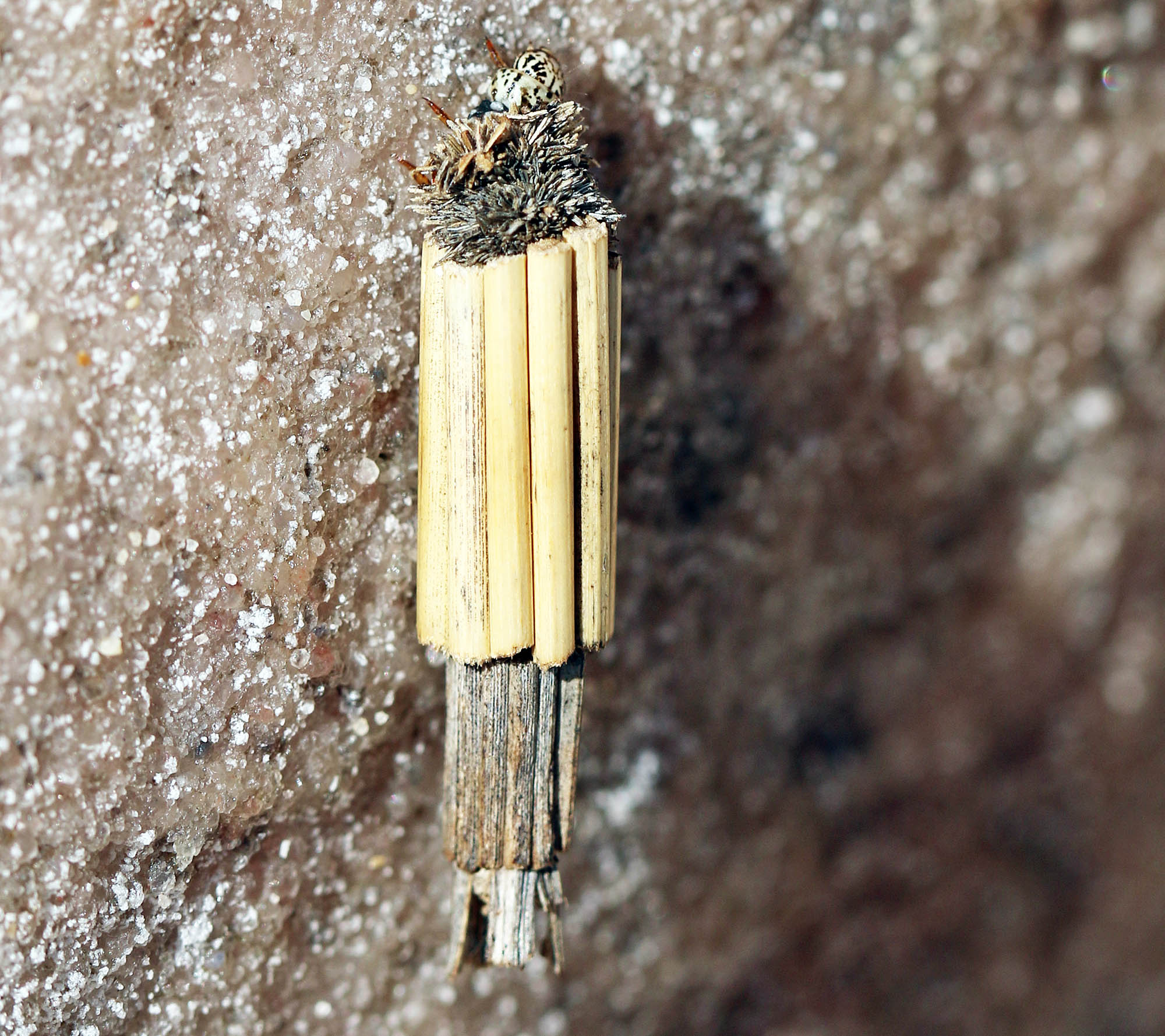
The order Hymenoptera includes all the wasps, bees and ants. One of the more familiar families is the Vespidae. It includes about 5000 species found all around the world, and includes most of the familiar social wasps.
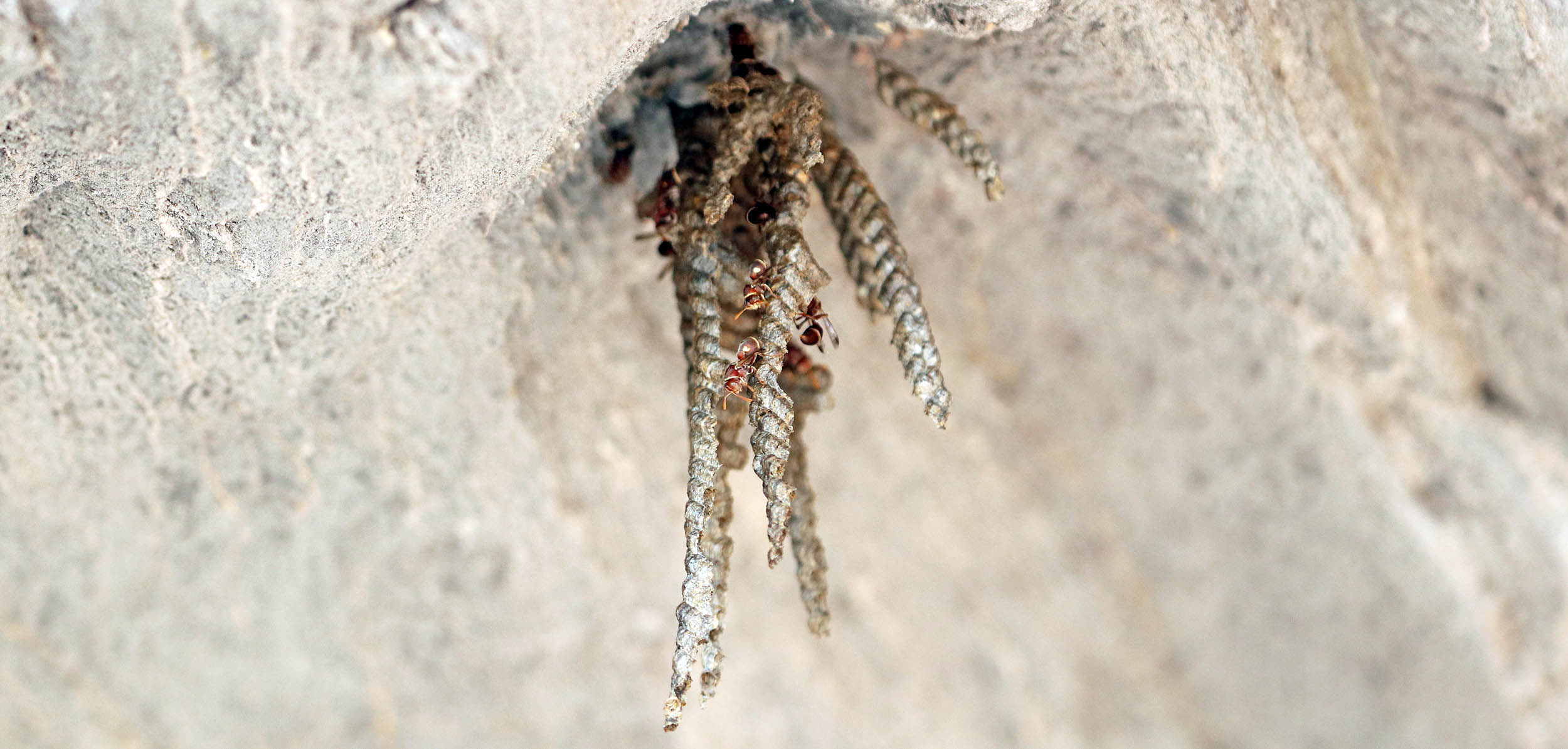 (Nares Point, W.A)
(Nares Point, W.A)Ropalidia spp. 'Paper Wasps' includes many species, found throughout warmer parts of Africa, Asia and Australasia.
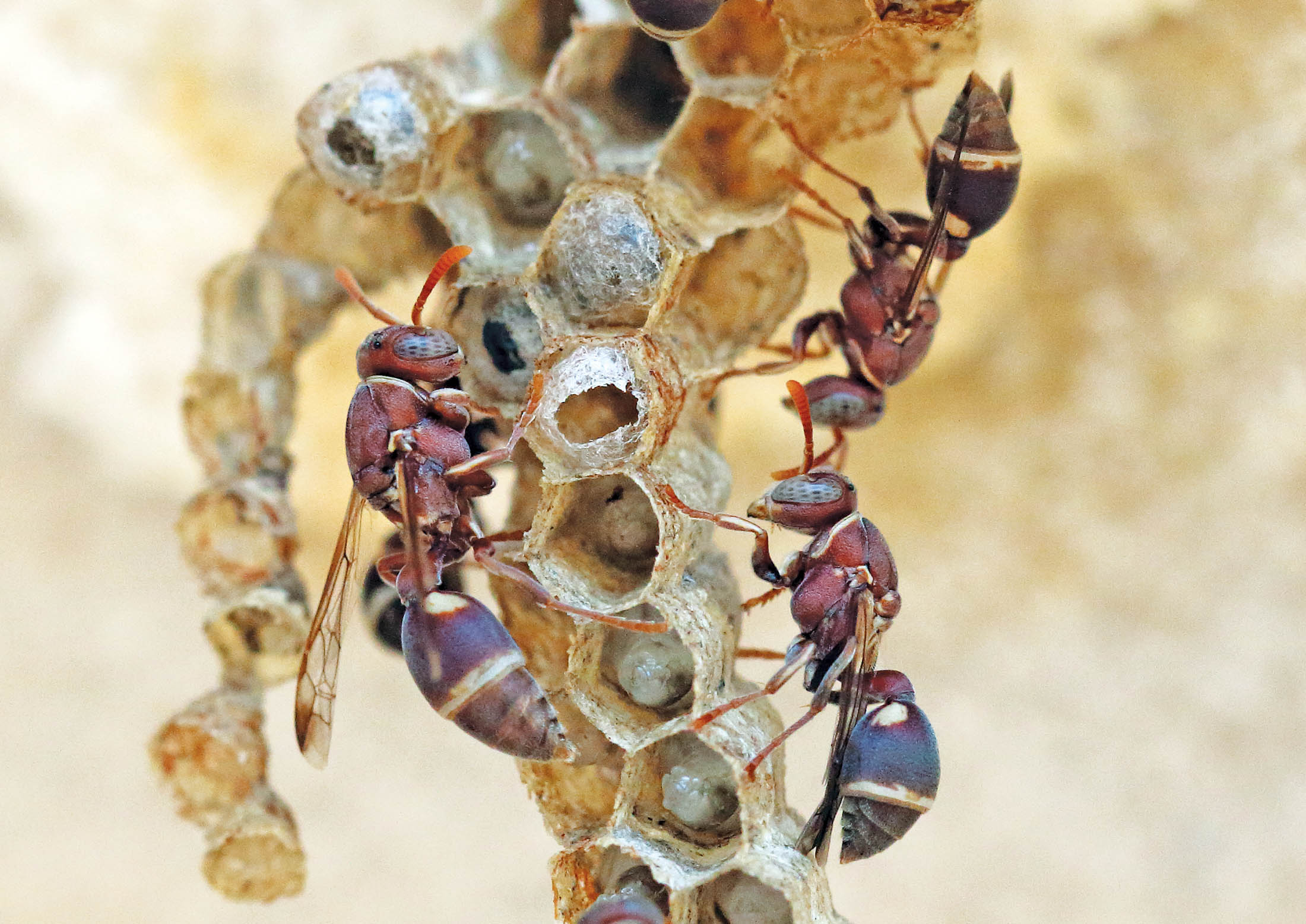
The family Apidae includes over 5000 species of bee found all over the world. The tribe Meliponini: includes the 'Stingless Bees'. These are tiny fly like bees. As the name suggests, they do not sting. Although they are mostly black, a closer look reveals many pretty variations. Below are species in the Tertragonula genus. There are about 30 species in this genus and they are found in various habitats throughout the tropics of Australasia and Asia. The image on the left are Tertragonula bees at the entrance to their nest. The image on the right is of Tertragonula bees with my finger, to give an idea of how small (and harmless) these bees are!
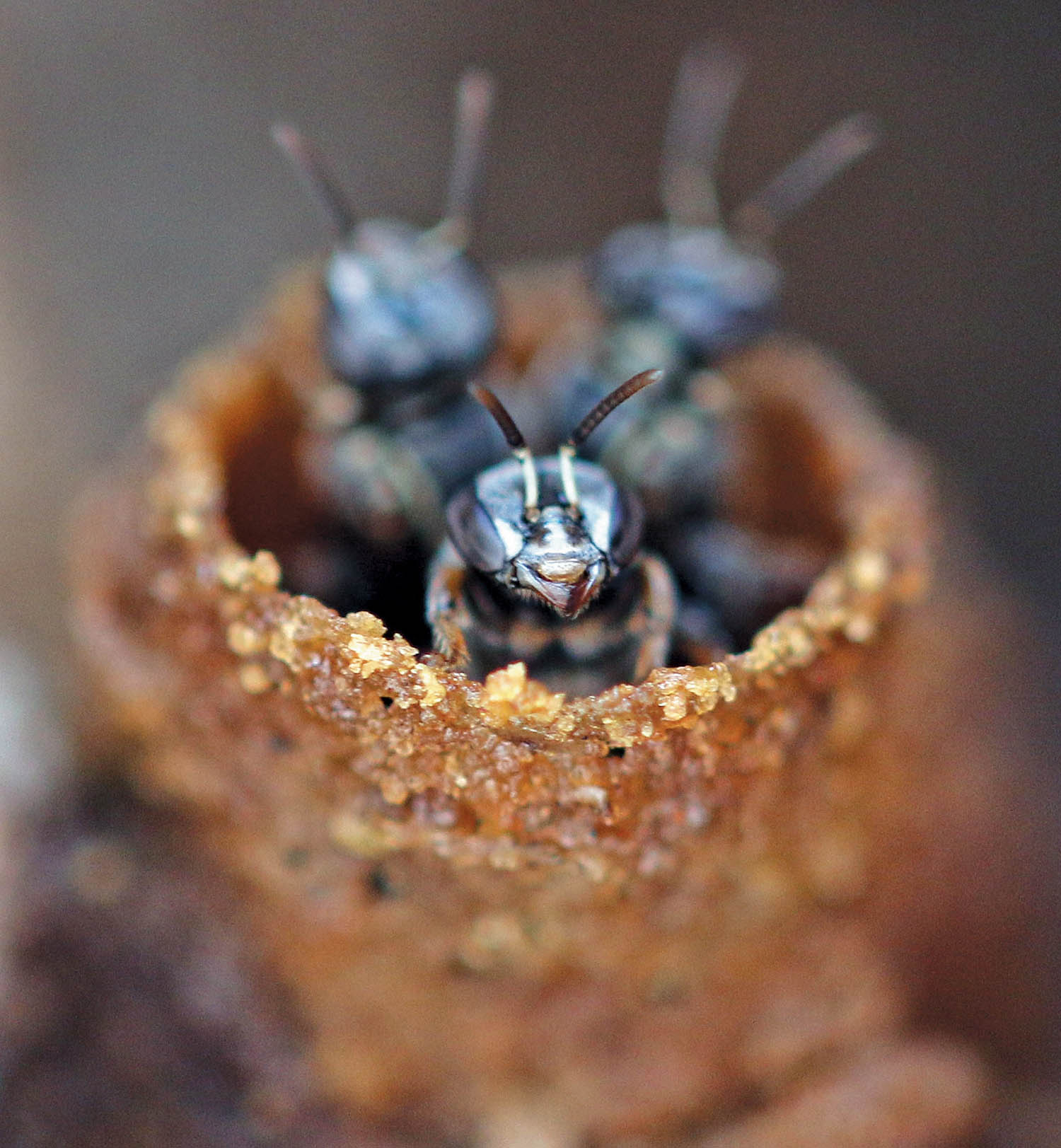 (Bigge Island, W.A.)
(Bigge Island, W.A.)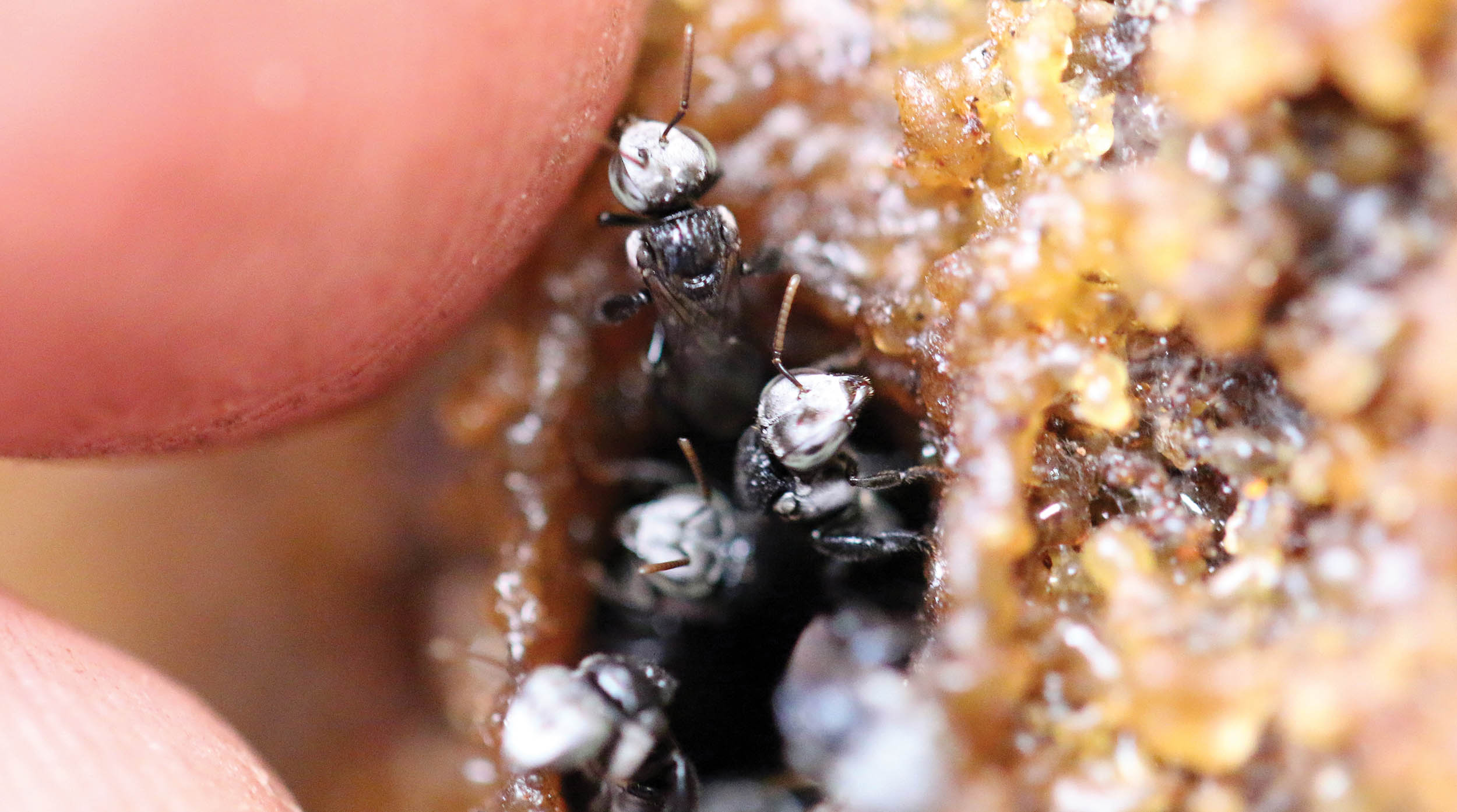 (Jar Island, W.A.)
(Jar Island, W.A.)There are thought to be over 22,000 species of ants in the family Formicidae, and of course they are EVERYWHERE! One of the coolest groups in the Australian tropical woodlands are the Opisthopsis spp., 'Jery Ants', 'Strobe Ants'. There are 13 species in this genus and they are endemic to Australasia. The genus name refers to the eyes at the back of their head. They seem to walk in peculiar and distinctive jerky motions.
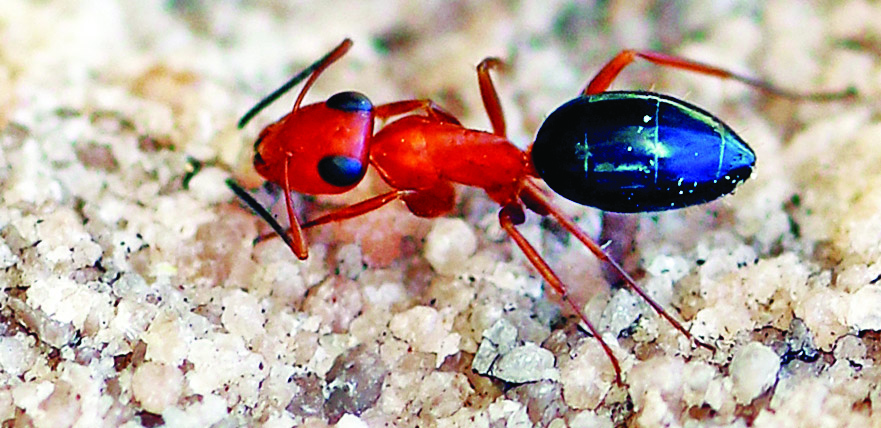 (Vansittart Bay, WA)
(Vansittart Bay, WA)'Weaver Ants' Oecophylla are found in the tropics of Africa, Asia and Australia. The generic name of Oecophylla means ‘house-leaf’ and refers to the fact that these ants make a nest out of leaves (while still attached to the tree); this is something very few other ants do. The establishment of a new colony is begun by the queen ant. She produces several larvae and these first adult workers then proceed to build a nest. Fresher leaves are usually selected because they are flexible and can be bent.
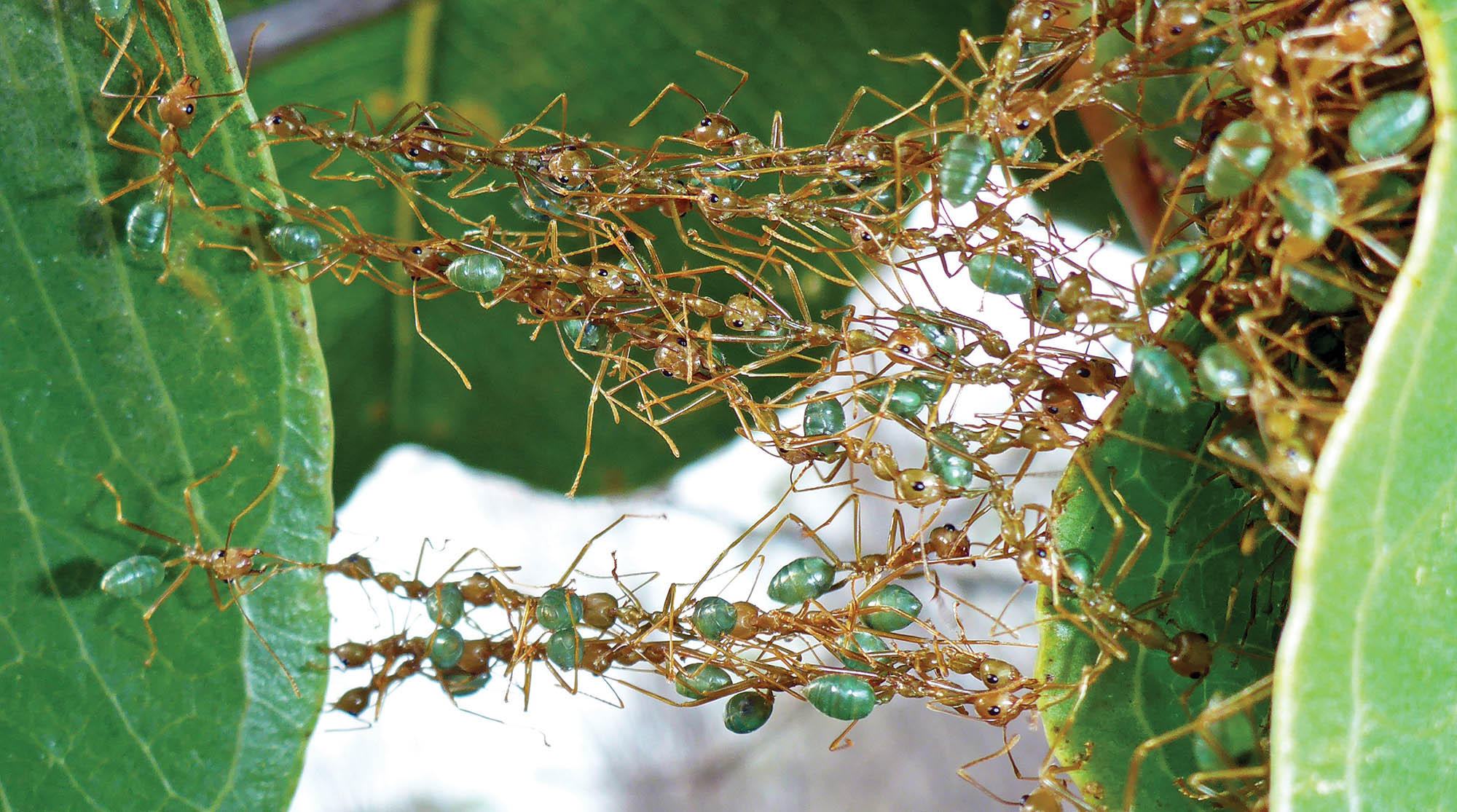
The ants may form bridges or chains with their bodies to bring the leaves together. Other ants then grab their larvae and squeeze silk out of their bodies like toothpaste from a tube. As the silk dries, it pulls the leaves together into a large, football-sized nest. The ants vigorously defend this nest, grabbing flesh with the mandible, then bending the abdomen over and squirting formic acid into the wound.
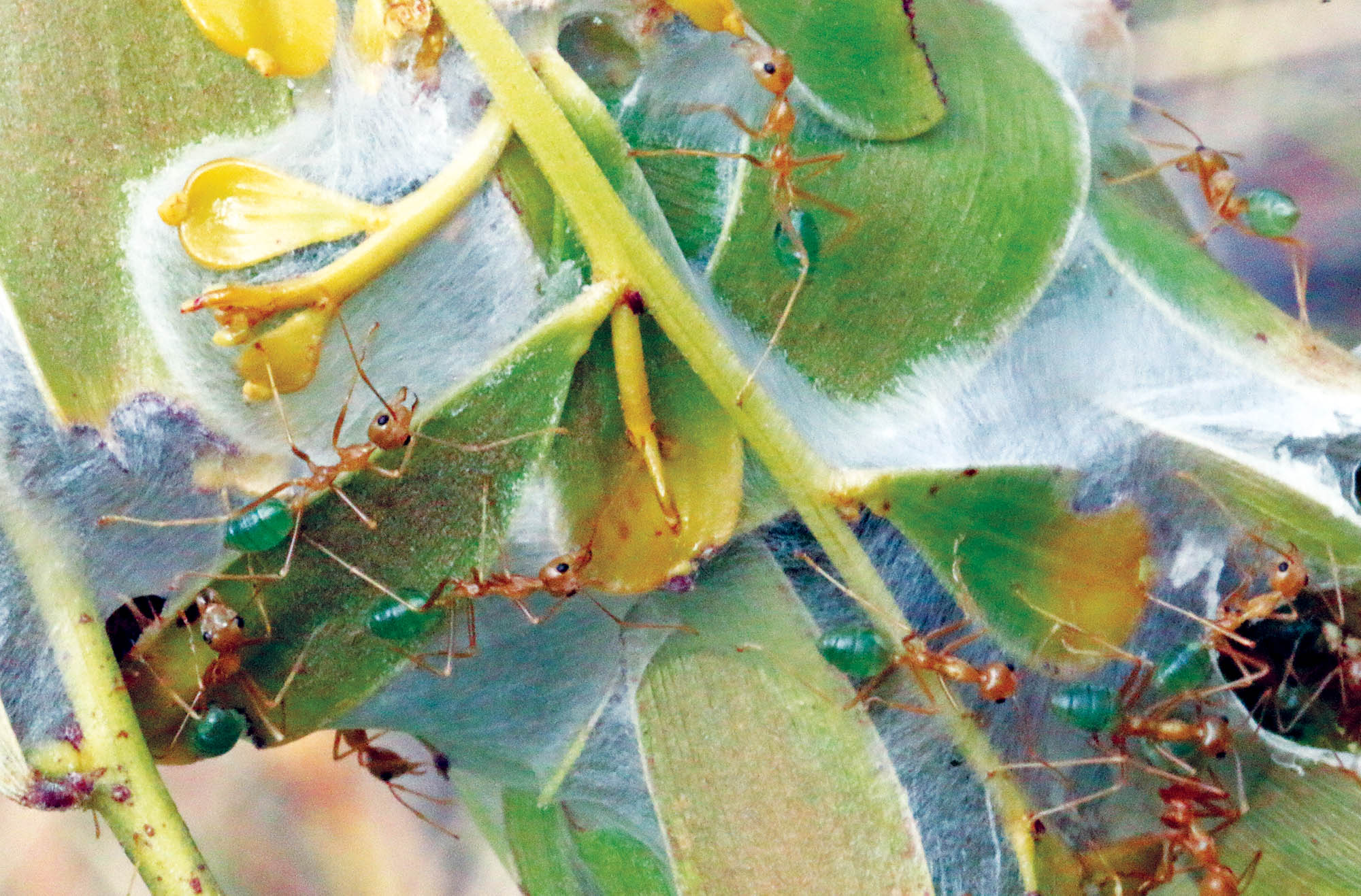 (Bigge Island)
(Bigge Island)There are now 2 recognized species with several different races, including the 1 species found in Australia: Oecophylla smaragdina. ‘Green Tree Ant’. When biting humans this results in a short, but sharp, sting, and this is how many people first interact with this species, probably the most commonly encountered ant in the Australian tropics. However, you can also bite back; as these animals are edible, and in fact quite tasty.
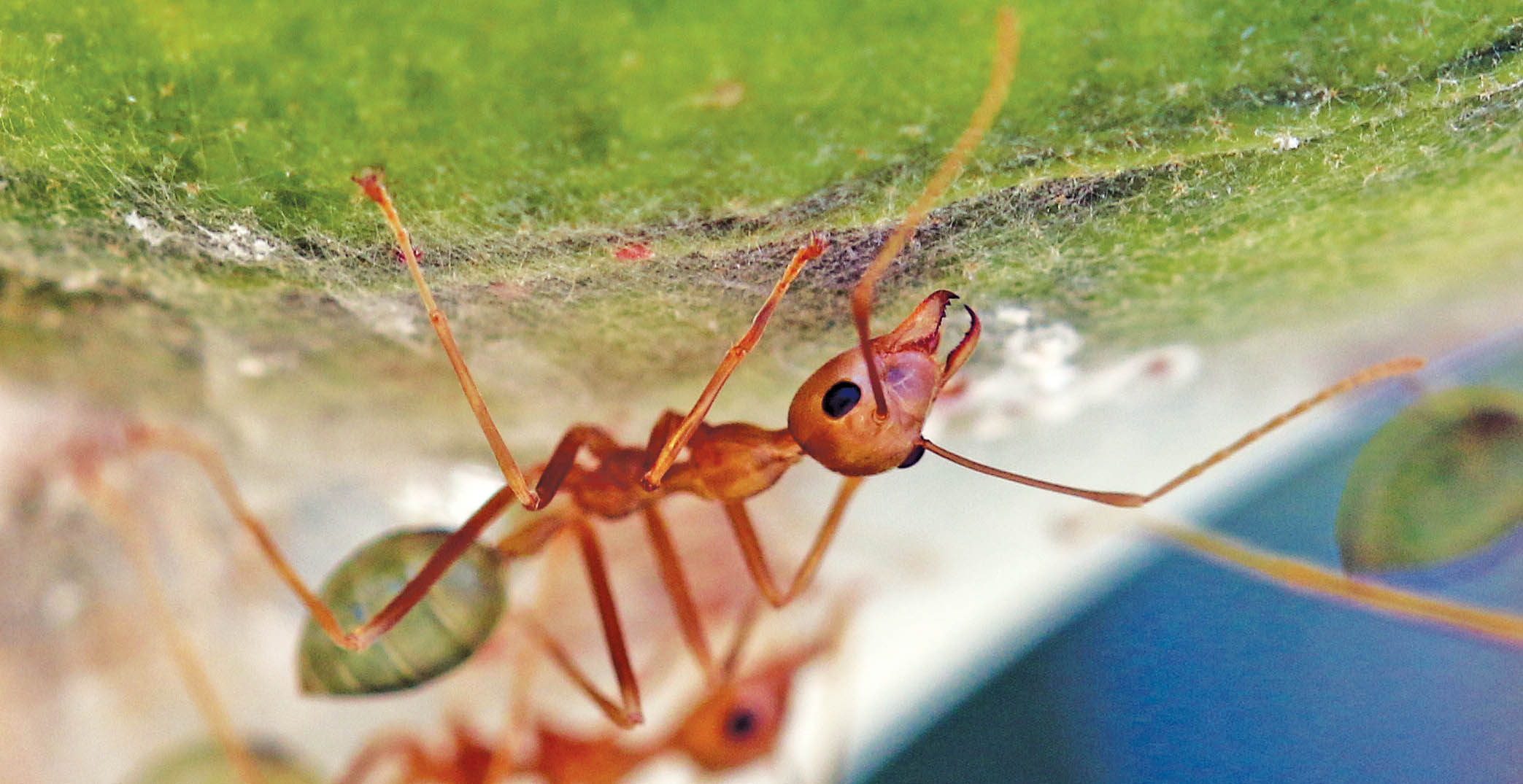 (Vansittart Bay)
(Vansittart Bay)The new family Pelodryadidae includes the 'Australasian Tree-frogs', split from the larger more widespread Hylidae. They are found across Australia and New Guinea. There are over 88 species found in the former region. Ranoidea (formerly Litoria) cavernicola, the 'Cave-dwelling Frog' is a medium-sized green frog is found mostly inside caves and around sandstone country, occasionally on vegetation around rocky escarpment. It is endemic to the Kimberley region of north-western Australia.
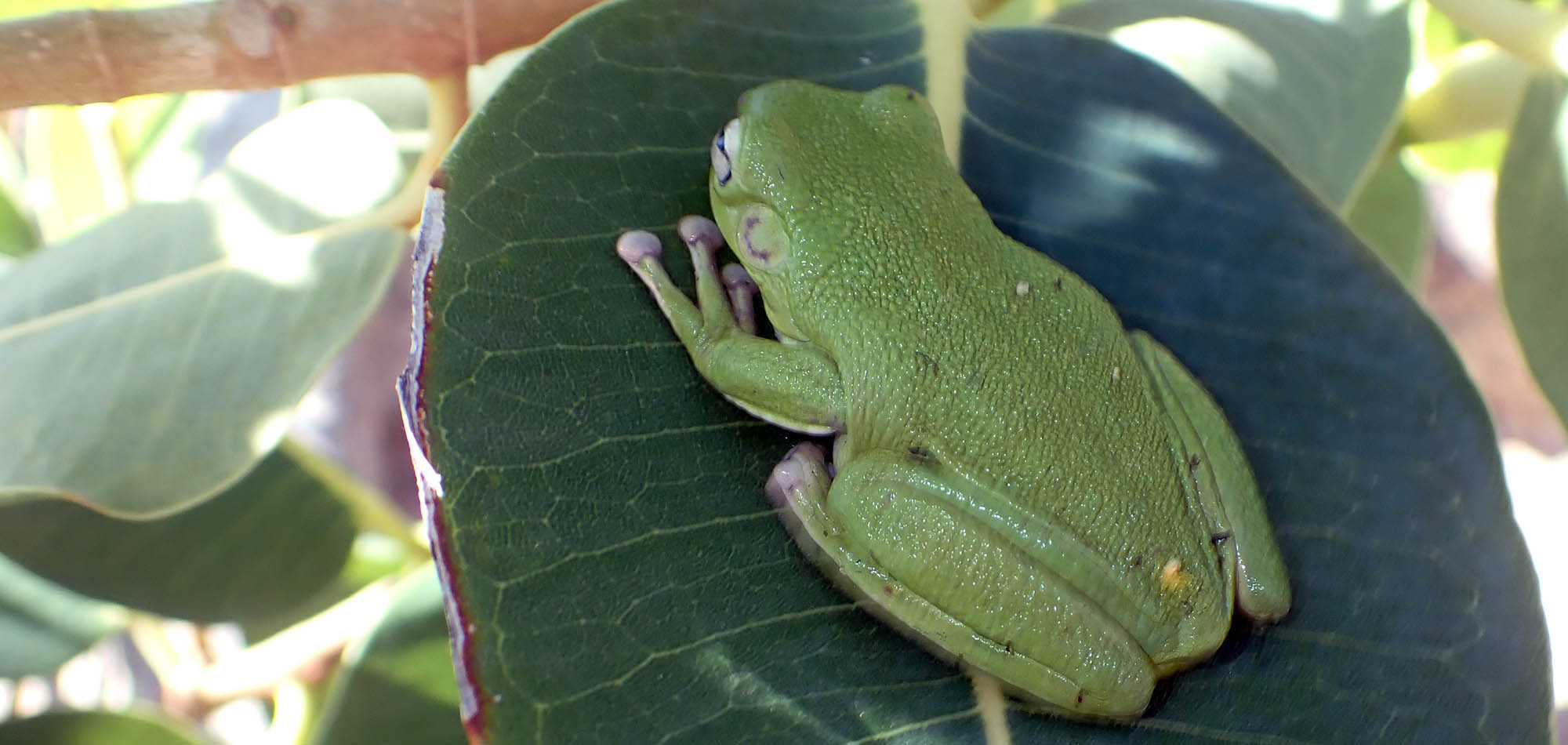 (Wollaston, Kimberley)
(Wollaston, Kimberley)Although not very obvious, there is a high diversity of reptiles in the woodlands of northern Australia.
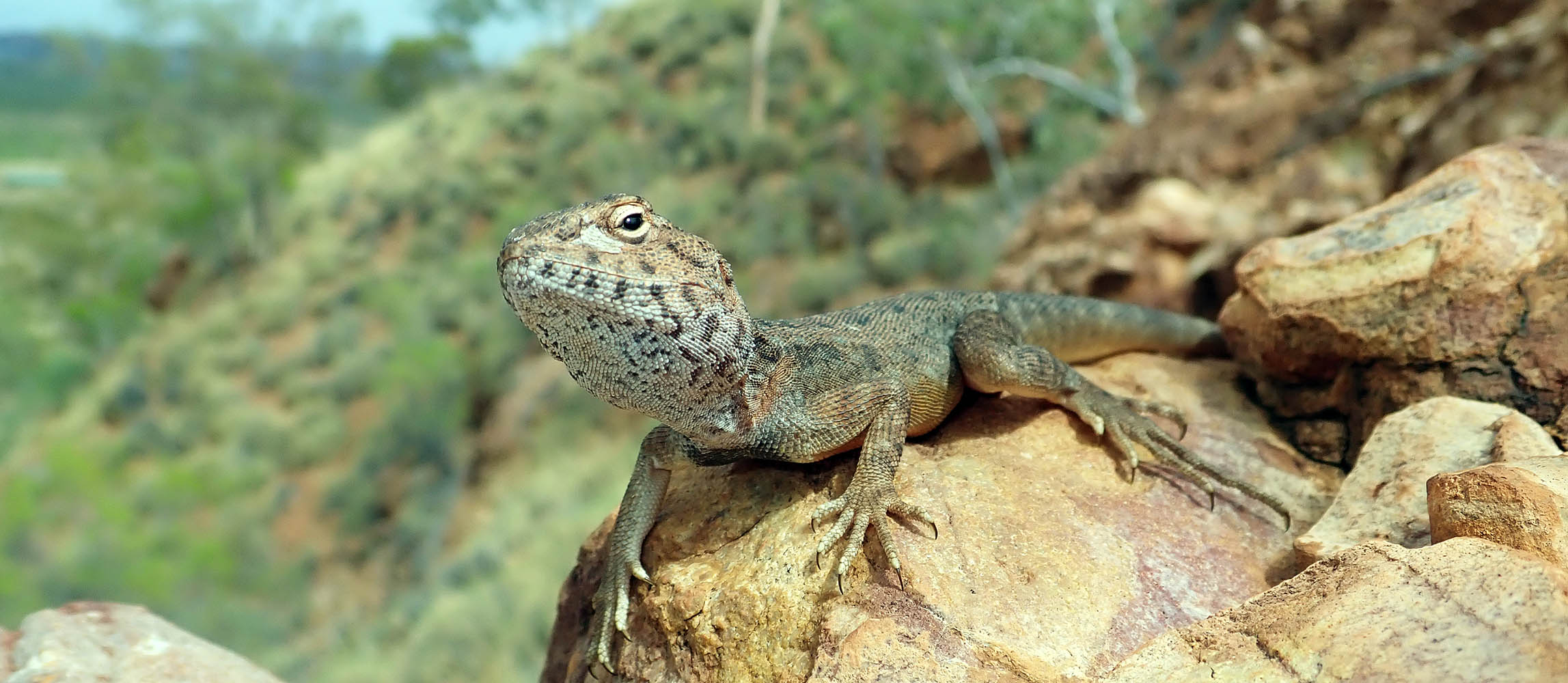 (Ring-tailed Dragon, Telstra Hill, Mt. Isa, Queensland)
(Ring-tailed Dragon, Telstra Hill, Mt. Isa, Queensland)Recently some of the species in the genus Lophognathus have been moved around; currently there are two species. They are one of several Australian dragons known as 'Ta-Ta' Lizards because of they way they signal with their forearm, lifting it up as a sign to other dragons. Lophognathus gilberti, 'Gilberts Ta-Ta Lizard'. This is the common species of 'Ta-Ta' Lizard around the suburbs of Darwin.
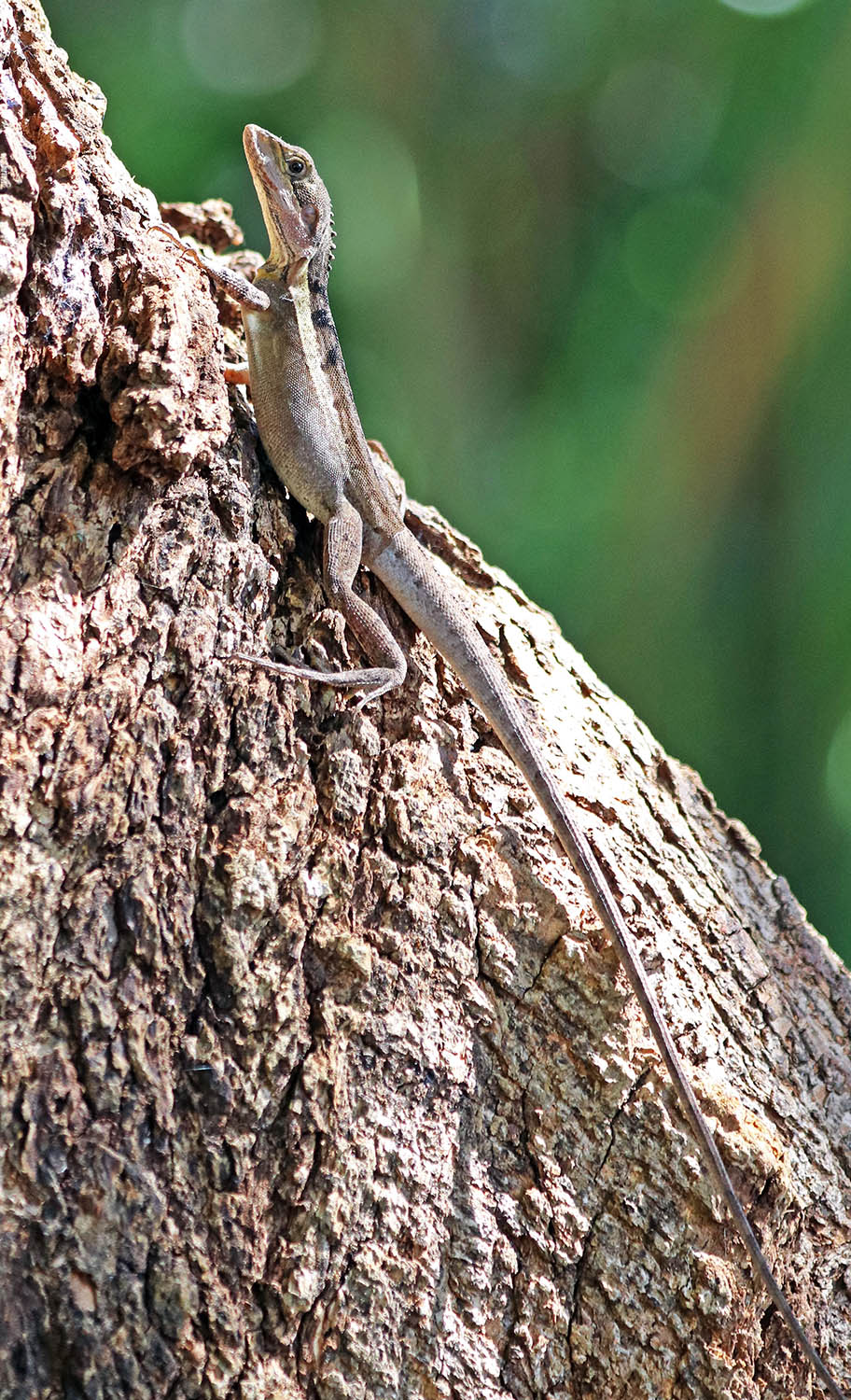 (George Brown Botanical Gardens, Darwin, NT)
(George Brown Botanical Gardens, Darwin, NT)Lophognathus horneri, 'Horner's Ta-Ta Lizard' (below) can be distinguished from the former by the white spot in the tympanum.
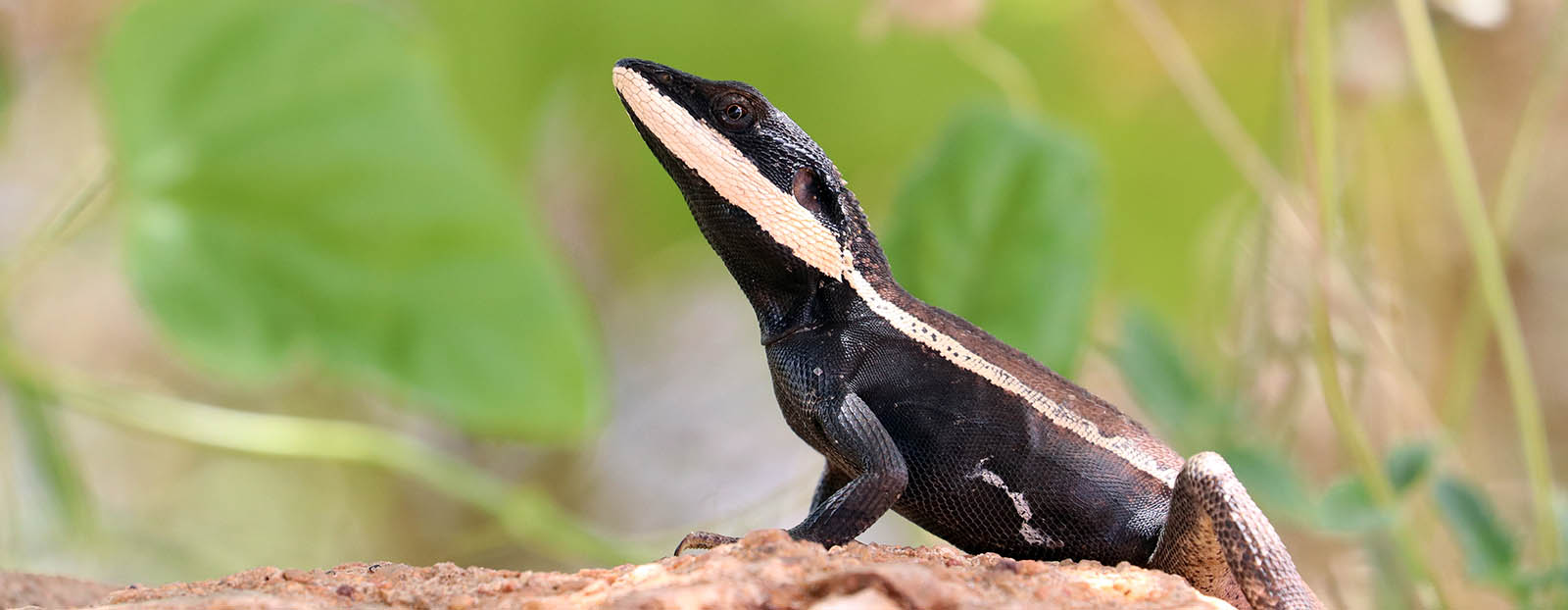 (Mt.Isa)
(Mt.Isa)The Varanidae contains all the monitor lizards, or 'Goannas' as they are known here. There are species in this family found in tropical Africa and across Asia, however it is in Australia where there is the highest diversity. And within this region, there are more species found in the tropical woodlands than other habitats.
 'Spiny-tailed Monitor' (Raft Point, Western Australia))
'Spiny-tailed Monitor' (Raft Point, Western Australia))For a lecture on the reptiles of the tropical Australian woodlands
The birds of the Australasian tropical woodlands include some of the largest and most colourful parrots on the planet. One of the most common and striking is the Red-winged Parrot; small flocks of these lime green birds race by with bright patches of crimson in their wings.
 (Red-winged Parrot, Bladensberg National Park)
(Red-winged Parrot, Bladensberg National Park)The Bee-eaters as a group are more diverse in the African and Asian tropics, but there is one species that is native and emblematic of the Australian tropical open woodlands in the southern winter: Merops ornatus, 'Rainbow Bee-eater'.
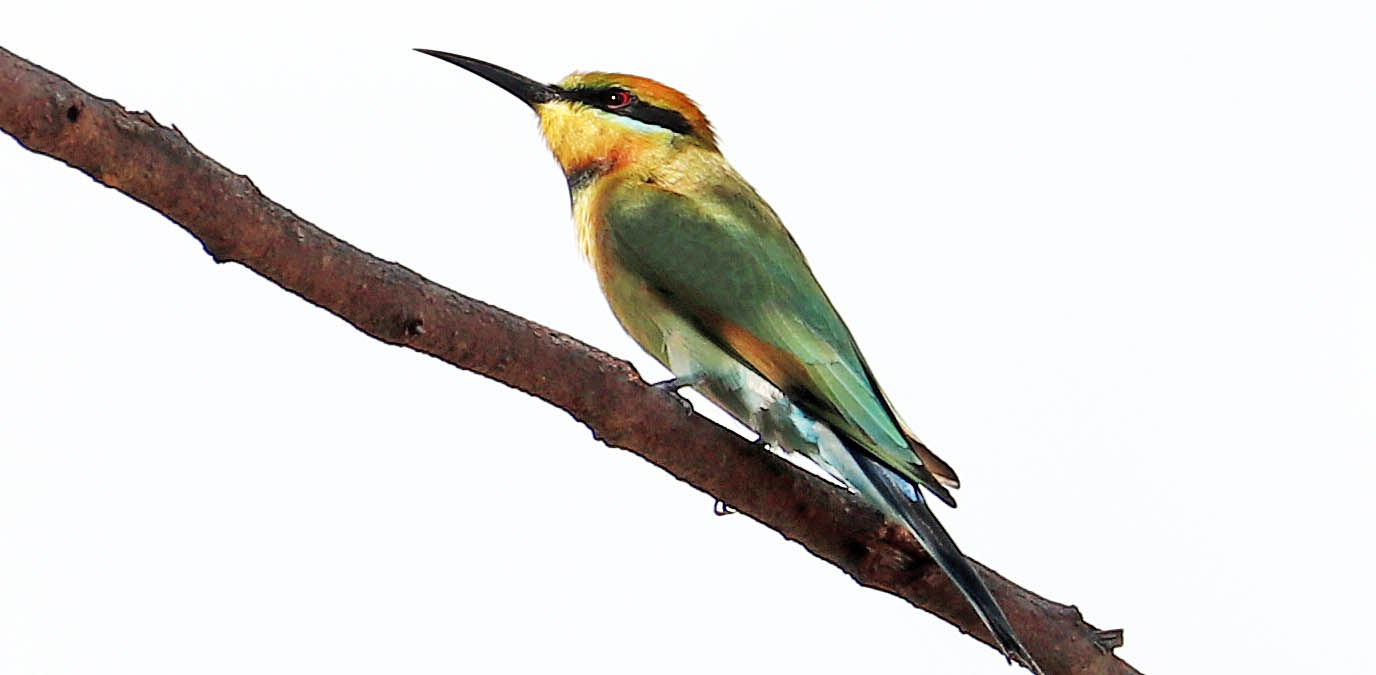 (George Brown Botanical Gardens, Darwin)
(George Brown Botanical Gardens, Darwin)The tiny Pardalotes of the family Pardalotidae are small but usually colourful if seen well. They mostly feed at the top of Eucalypts, and are thus spread across many of Australia's habitats. Due to their size and canopy dwelling habit, they are usually not noticed until they are head, as most species have distinctive 'morse code' like calls. For example, the species below, the 'Striated Pardalote' Pardalotus striatus, emit a familiar and fast repeated sharp double note (or triple) call.
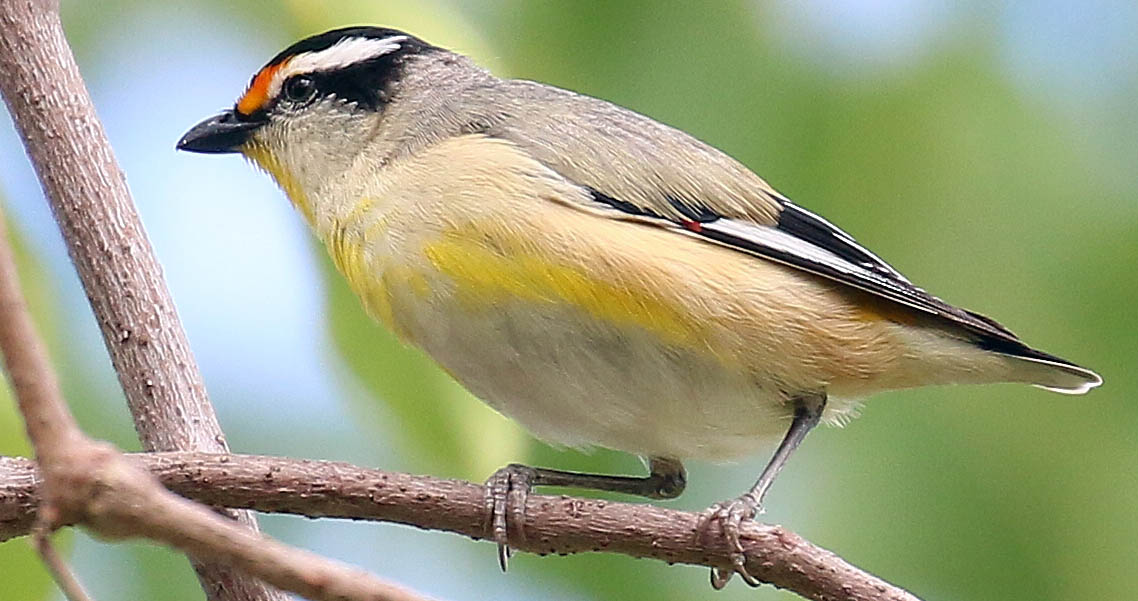
Throughout the warmer parts of the world there are always birds that have evolved to feed specifically on nectar. In Australasia, it is the honeyeaters. They are the biggest family of birds in Australia, including in the northern tropical woodlands. Despite the name, honeyeaters do not exclusively feed on nectar, for while it is high in energy giving carbohydrates (i.e.; sugar); it is low in nutrients. Thus, most honeyeaters probably couldn’t survive without including a few protein rich insects in their diet. Some ingest them as a consequence of feeding from flowers. Many of the physical features of honeyeaters are reflections of their nectar feeding lifestyle. Most have a bill that is curved to some extent, with the bill shape largely reflects the types of flowers they are visiting.
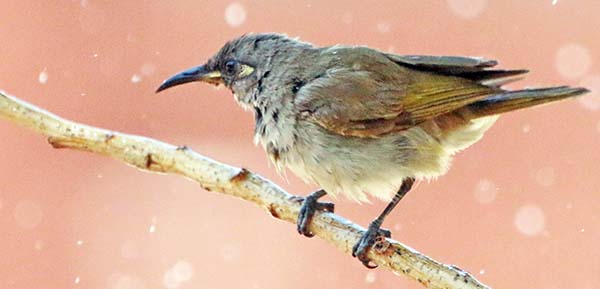 'Brown Honeyeater', (Wyndham Caravan Park, Western Australia)
'Brown Honeyeater', (Wyndham Caravan Park, Western Australia)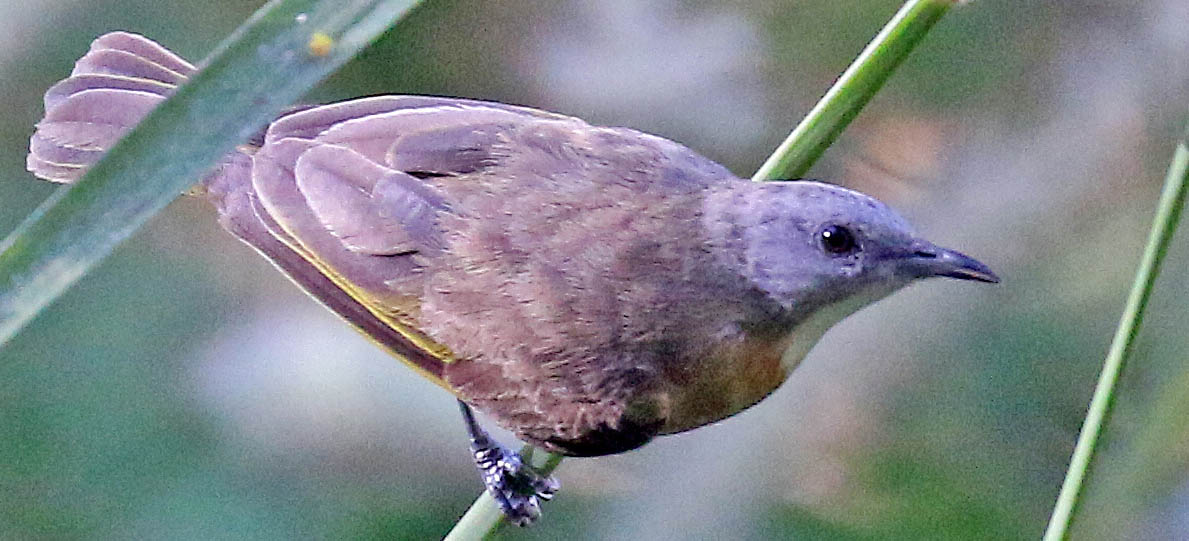 'Rufous-banded Honeyeater', (Rapid Creek, NT)
'Rufous-banded Honeyeater', (Rapid Creek, NT)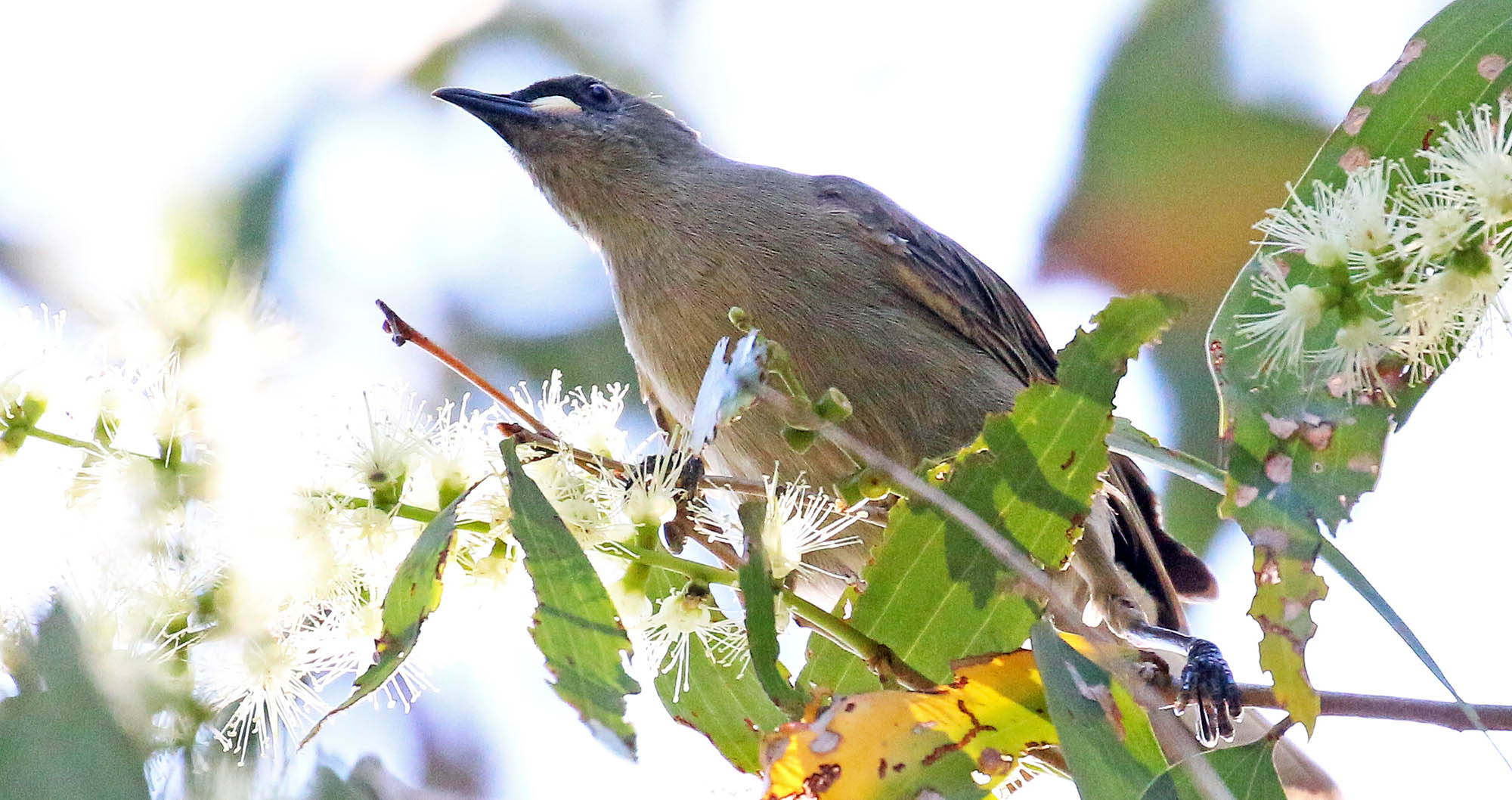 'White-gaped Honeyeater', (Rapid Creek, Darwin, N.T)
'White-gaped Honeyeater', (Rapid Creek, Darwin, N.T) 'Rufous-throated Honeyeater'.
'Rufous-throated Honeyeater'.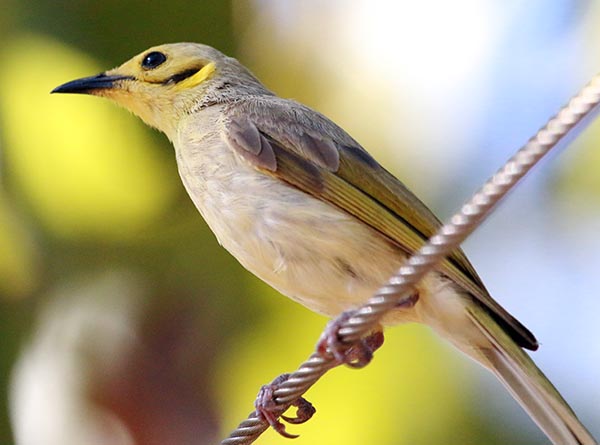 'Yellow-tinted Honeyeater', (Wyndham Caravan Park, Western Australia).
'Yellow-tinted Honeyeater', (Wyndham Caravan Park, Western Australia).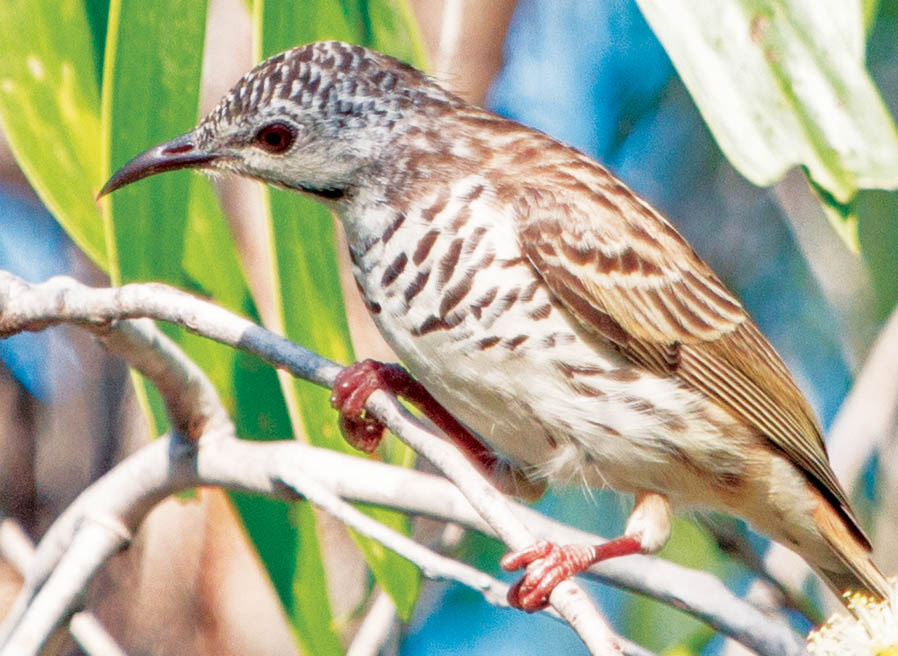 'Bar-breasted Honeyeater', (Vansitart Bay, Western Australia)
'Bar-breasted Honeyeater', (Vansitart Bay, Western Australia)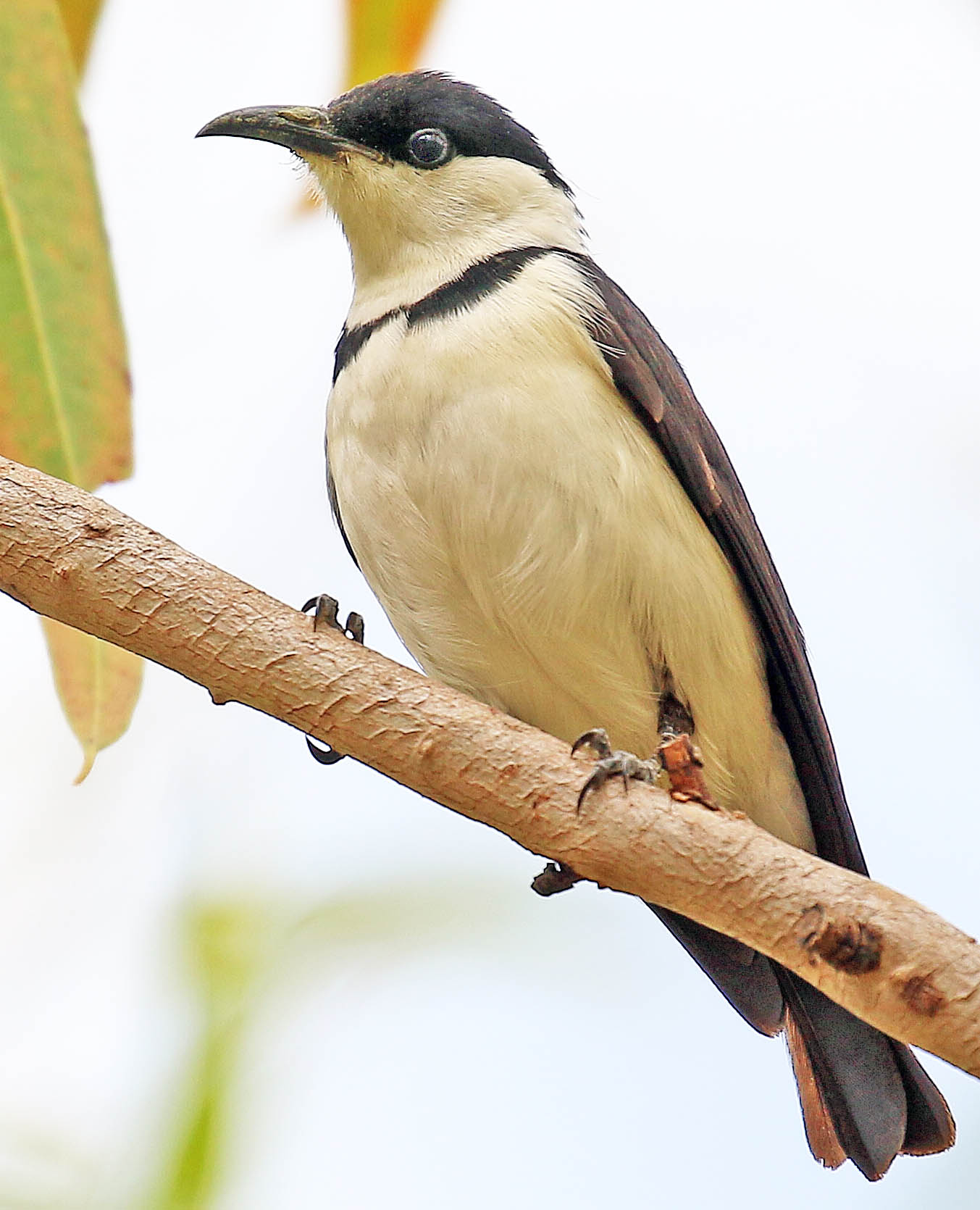 'Banded Honeyeater', "Follow that flower!"
'Banded Honeyeater', "Follow that flower!"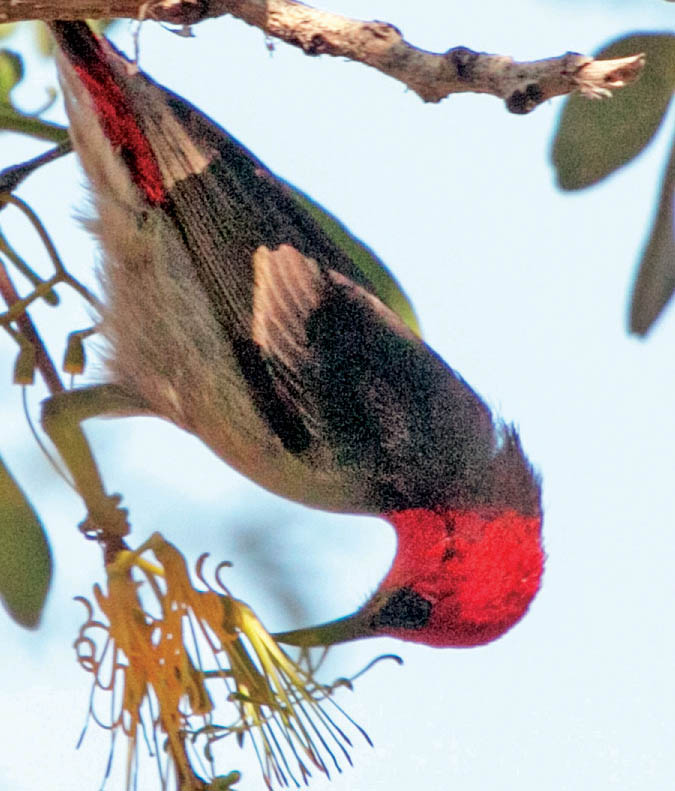 'Red-headed Honeyeater/Myzomela', (Wyndham, W.A.)
'Red-headed Honeyeater/Myzomela', (Wyndham, W.A.)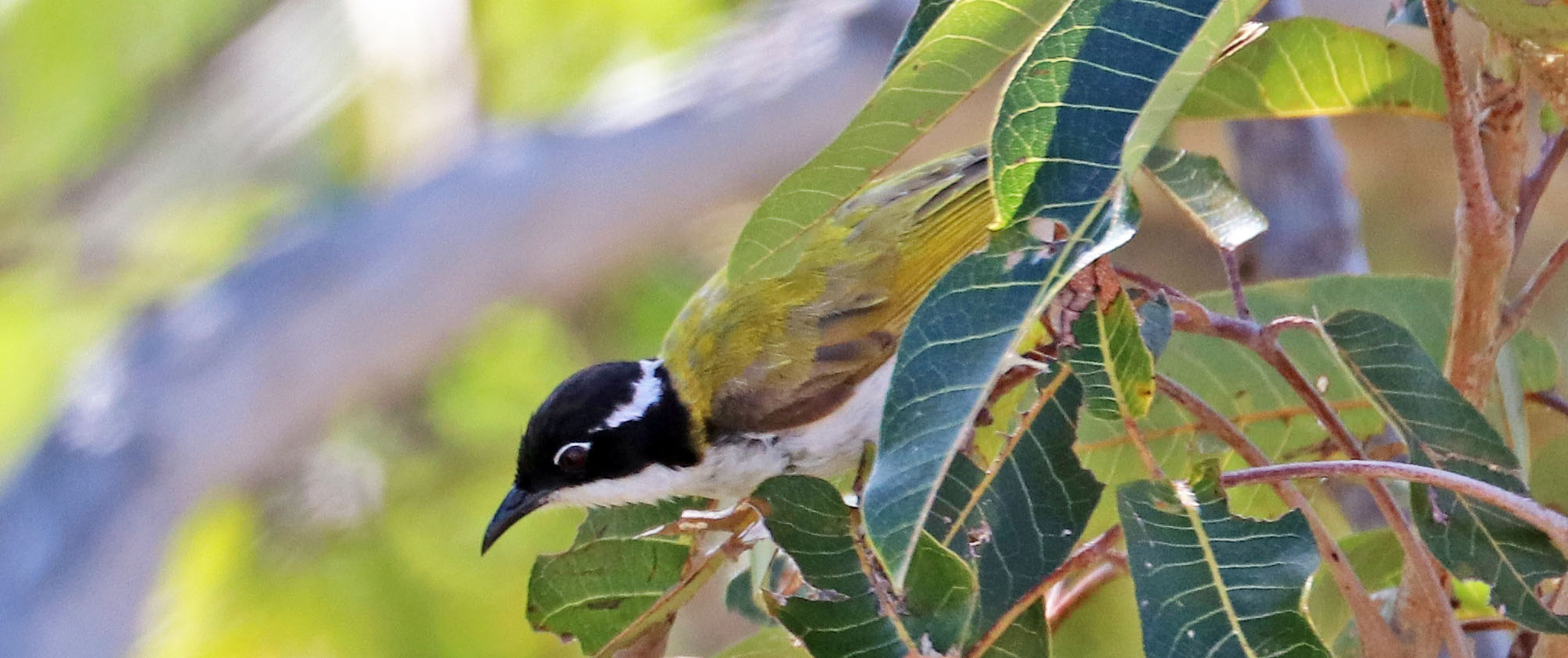 'White-throated Honeyeater', (Freshwater, WA)
'White-throated Honeyeater', (Freshwater, WA)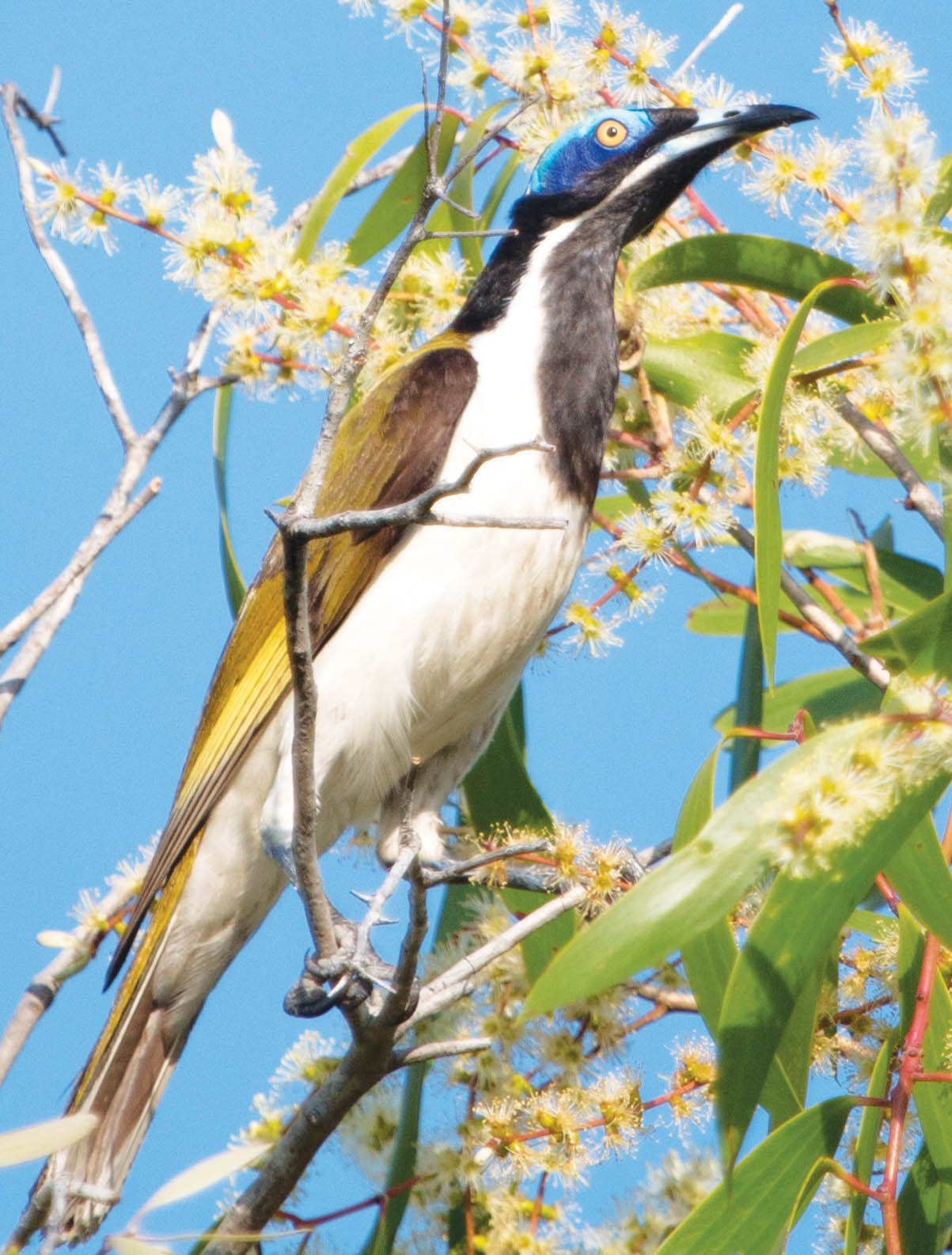 'Blue-faced Honeyeater', (Vansittart Bay)
'Blue-faced Honeyeater', (Vansittart Bay)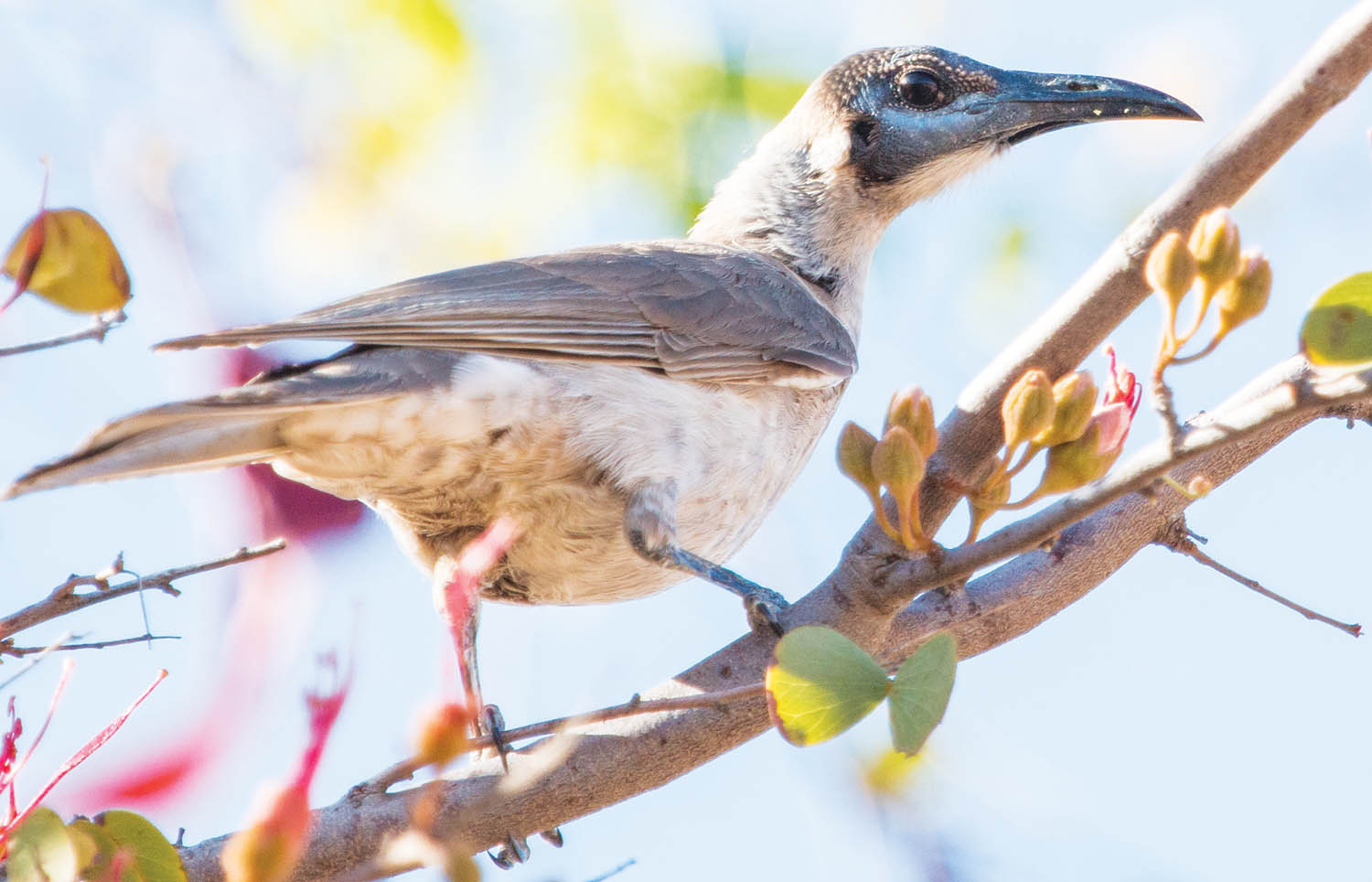 'Little Friarbird', (Wyndham, Western Australia)
'Little Friarbird', (Wyndham, Western Australia)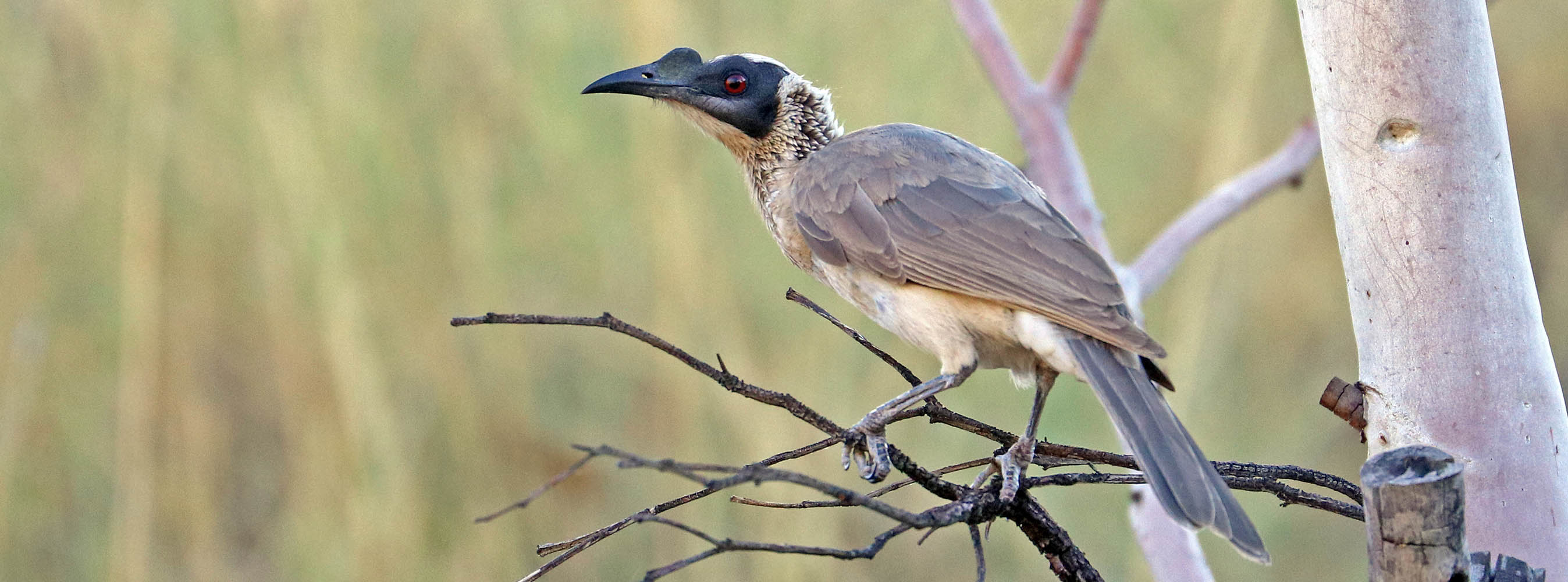 'Silver-crowned Friarbird', (Lake Moondarah, Mt. Isa)
'Silver-crowned Friarbird', (Lake Moondarah, Mt. Isa)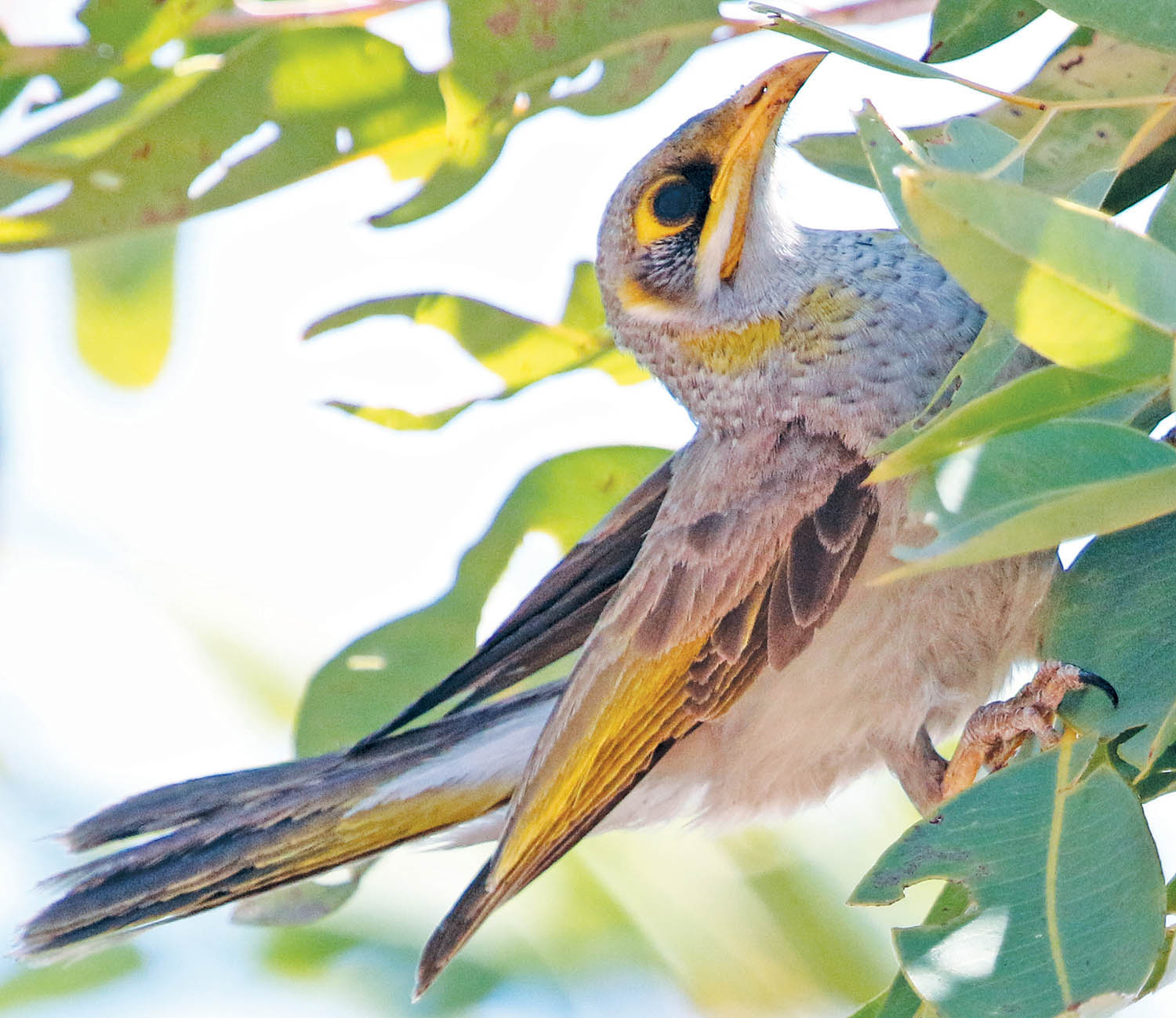 'Yellow-throated Miner'.
'Yellow-throated Miner'.There are five species of 'Australasian Babblers'. The species usually seen in the tropical woodlands is Pomatostomus temporalis, 'Grey-crowned Babbler'. They are noisy birds that hang out in gangs that often make almost comical sounds.
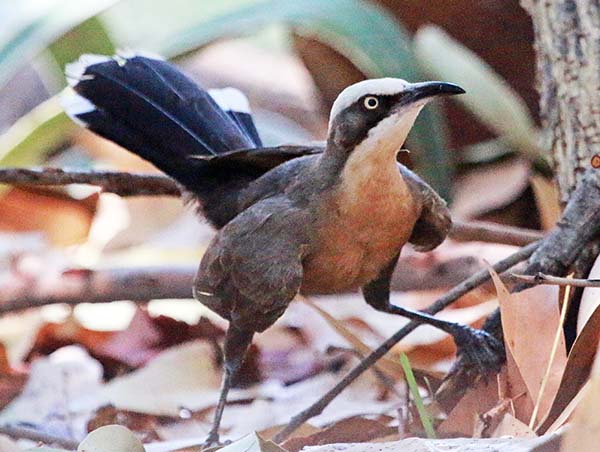 (Wyndham Caravan Park, Western Australia)
(Wyndham Caravan Park, Western Australia)The Old World tropical family Campephagidae include the Trillers, Minivets, and the 'Cuckooshrikes'. They are neither cuckoos, nor shrikes. The Black-faced and White-bellied Cuckoo Shrikes are two of the more common canopy birds of the Australian tropical open woodlands; although because of their grey colouration, may be missed, however, one of the most distinctive features of these two species is that when they land they have the habitat of re-arranging their wings.
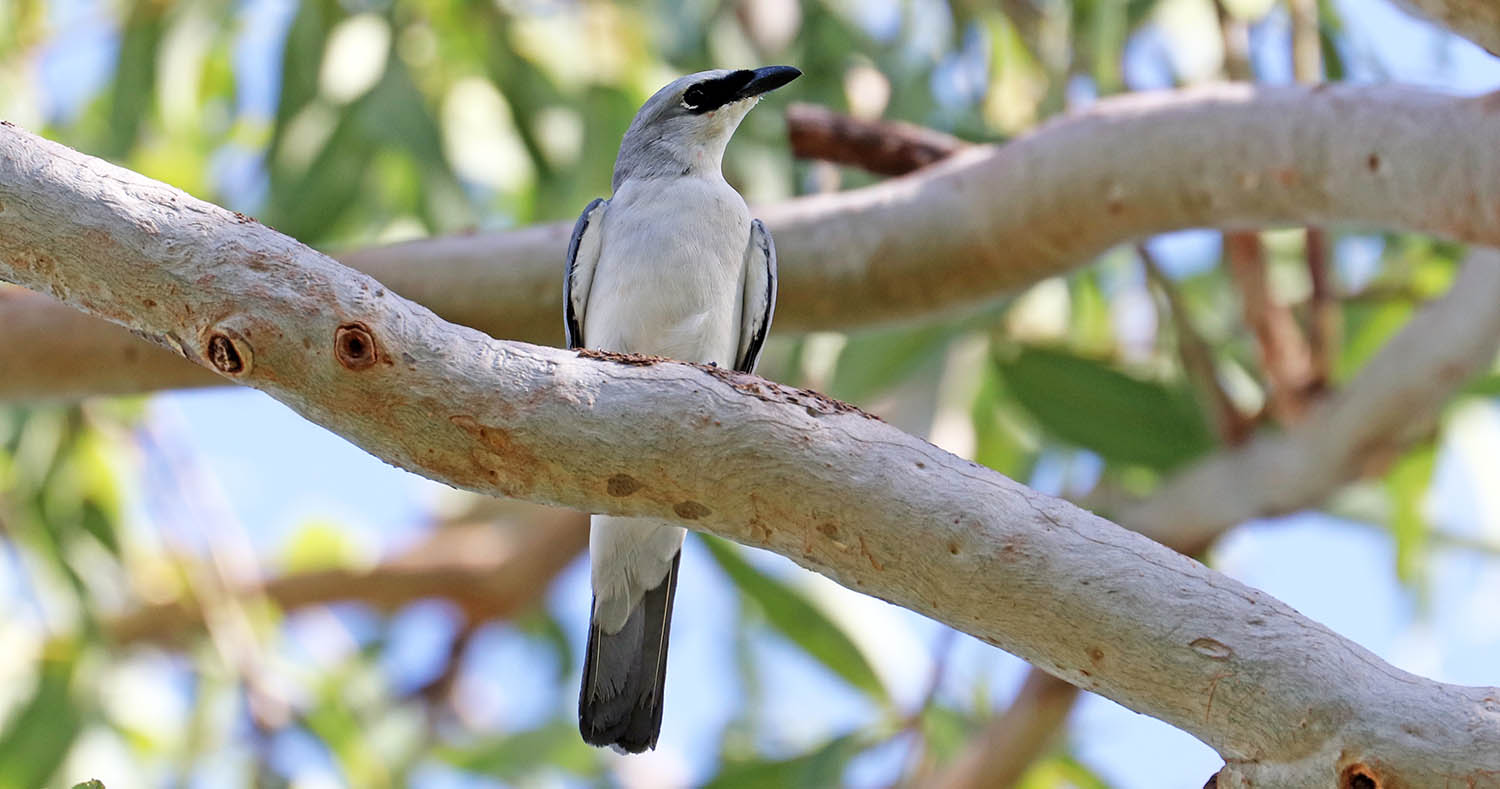 'White-bellied Cuckoo-Shrike', (George Brown Botanical Gardens, Darwin, NT)
'White-bellied Cuckoo-Shrike', (George Brown Botanical Gardens, Darwin, NT)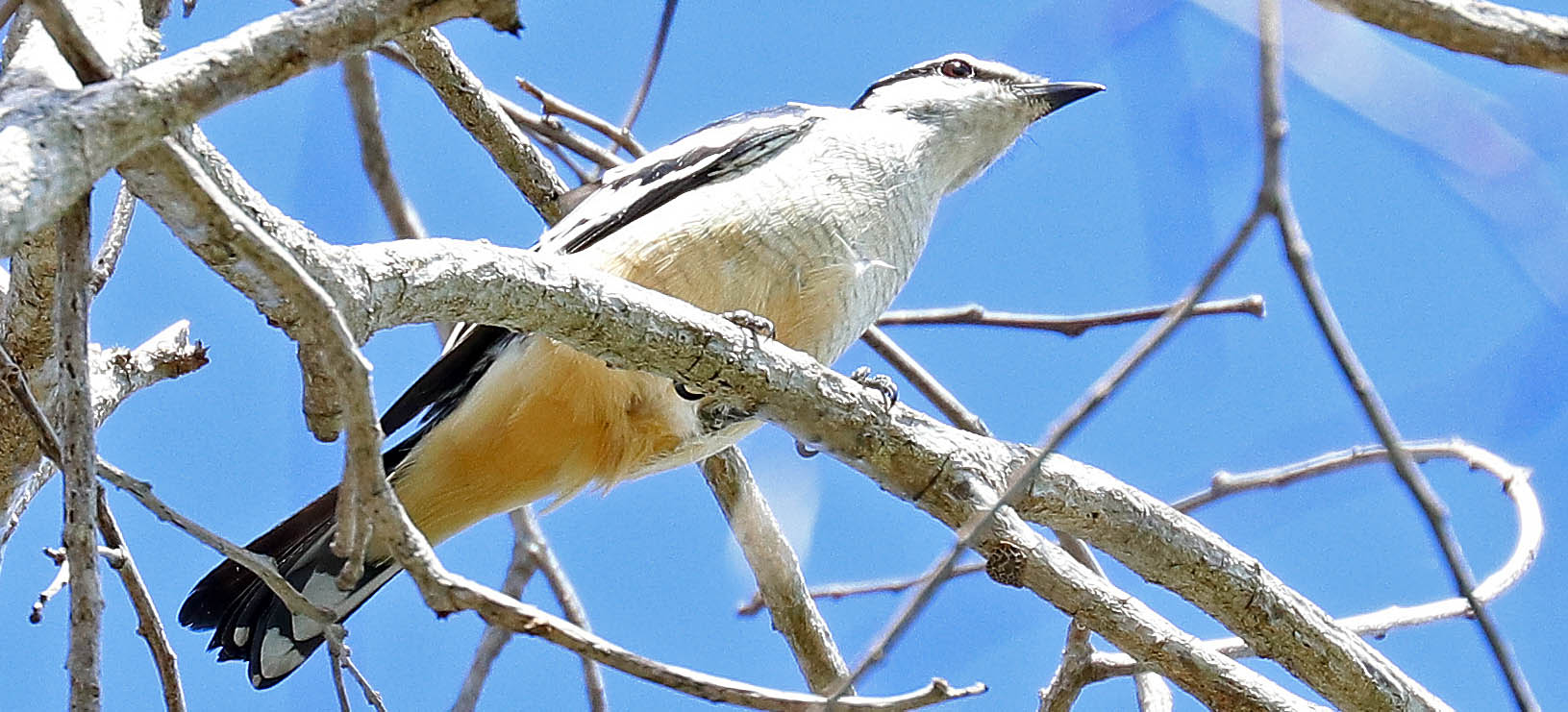 'Varied Triller', (Tiwi Islands, Northern Territory)
'Varied Triller', (Tiwi Islands, Northern Territory)The family Dicaeidae is most fully represented in tropical Asia by over 50 species of what are mostly called 'Flowerpeckers', however there is one very widepread species in Australia; Dicaeum hirundinaceum, the 'Mistletoebird'. As suggested by the common name, feeds on mistletoe berries and disperses sticky seeds by wiping them tree branches. It is found across most of Australia, except the western deserts and Tasmania, and is common in the Eucalyptus dominated tropical woodlands.
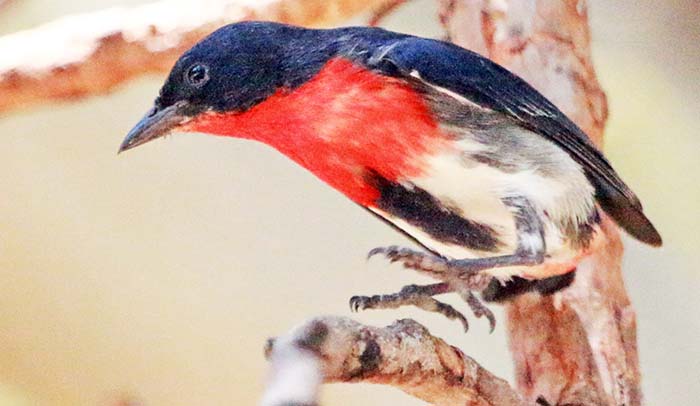 (Wyndham Caravan Park, Western Australia)
(Wyndham Caravan Park, Western Australia)The family Estrildidae includes the 'Grass Finches', including Munias, Mannikins, Firetails, Firefinches, and Parrotfinches. These are not related to the 'true finches', sparrows or buntings. Because they mostly feed on the seeds of grasses, they are sometimes knows as 'Grass Finches' to differentiate them from other birds called 'finches'. They are mostly found in the tropical parts of the Old World, with two main radiations in Africa and Australia.
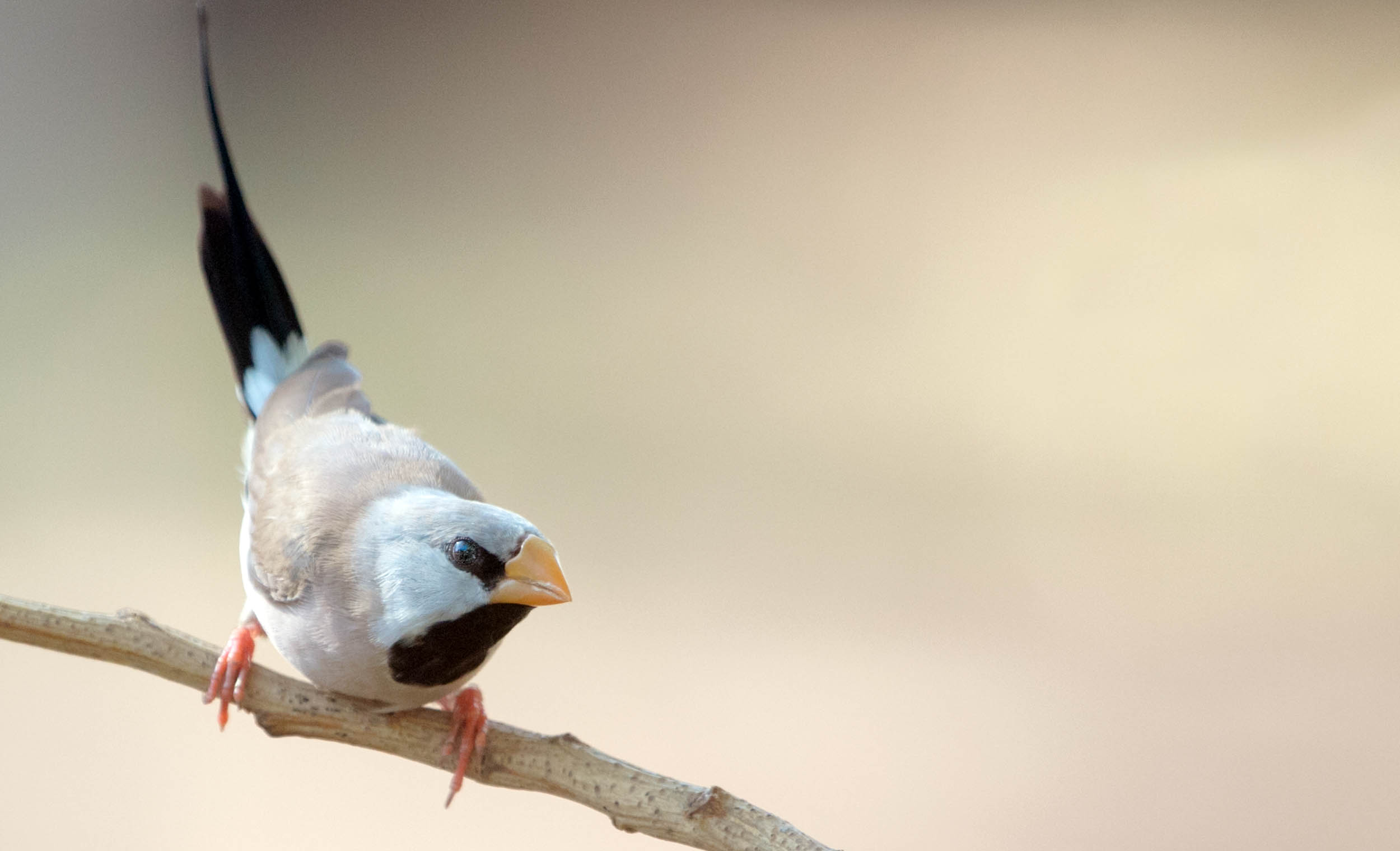 'Long-tailed Finch', (Wyndham Caravan Park, Western Australia)
'Long-tailed Finch', (Wyndham Caravan Park, Western Australia)These birds are common and diverse in the tropical woodlands of northern Australia. Because they eat seeds, they need to drink most days. Therefore, to see them, it is best to hide near a waterhole (or bird pond as in images below) in the morning at the end of the dry season.
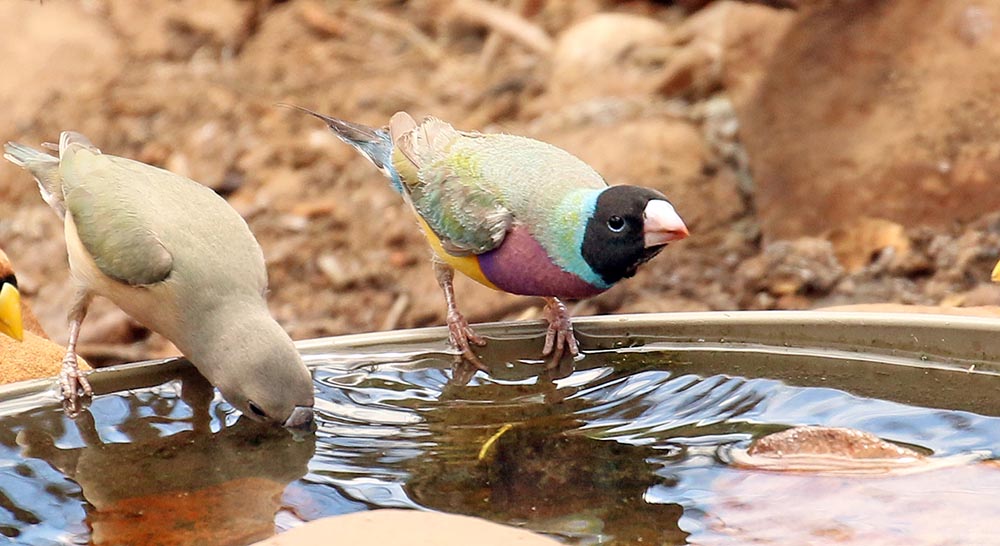 'Gouldian Finch', (Wyndham Caravan Park, Western Australia)
'Gouldian Finch', (Wyndham Caravan Park, Western Australia)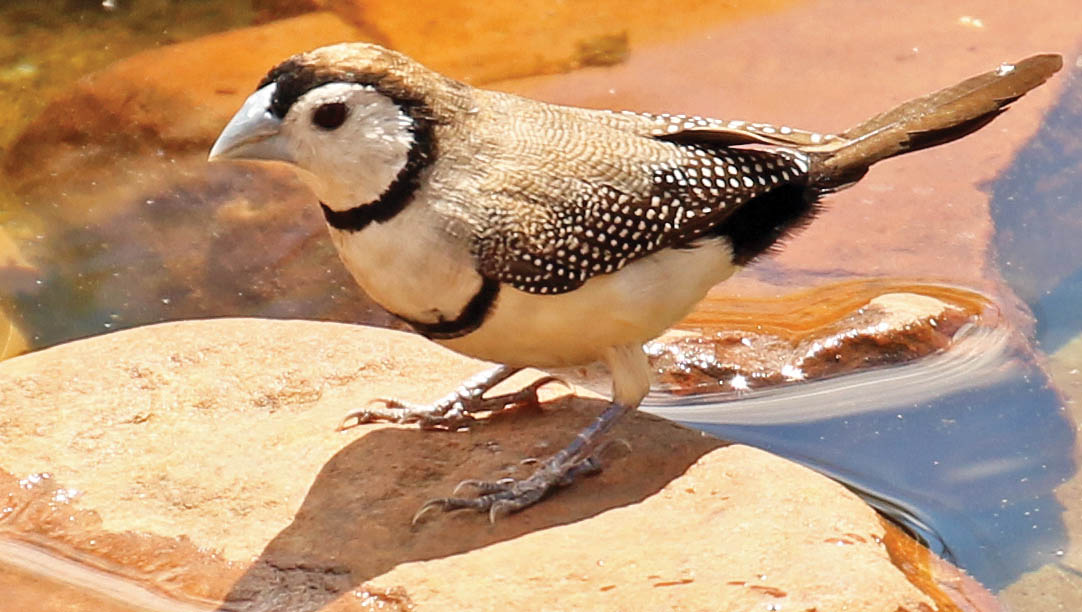 'Double-barred Finch', (Wyndham)
'Double-barred Finch', (Wyndham)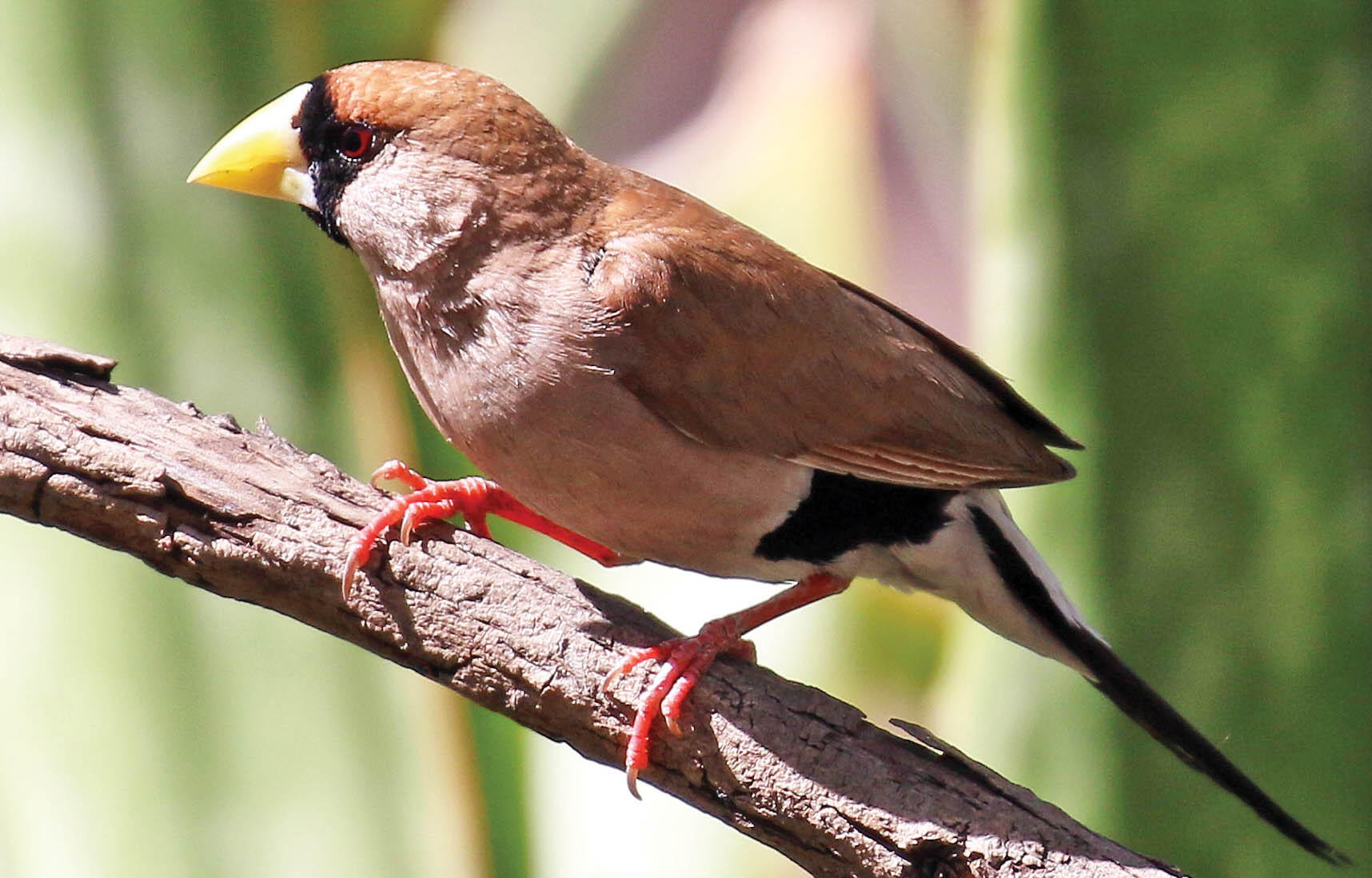 'Masked Finch', (Wyndham Caravan Park, Western Australia)
'Masked Finch', (Wyndham Caravan Park, Western Australia)The savanna woodlands are a great place to see many classic open country mammals, especially the kangaroos and wallabies of the family Macropodidae. The most common species is Macropus agilis, 'Agile Wallaby', 'Sandy Wallaby' i
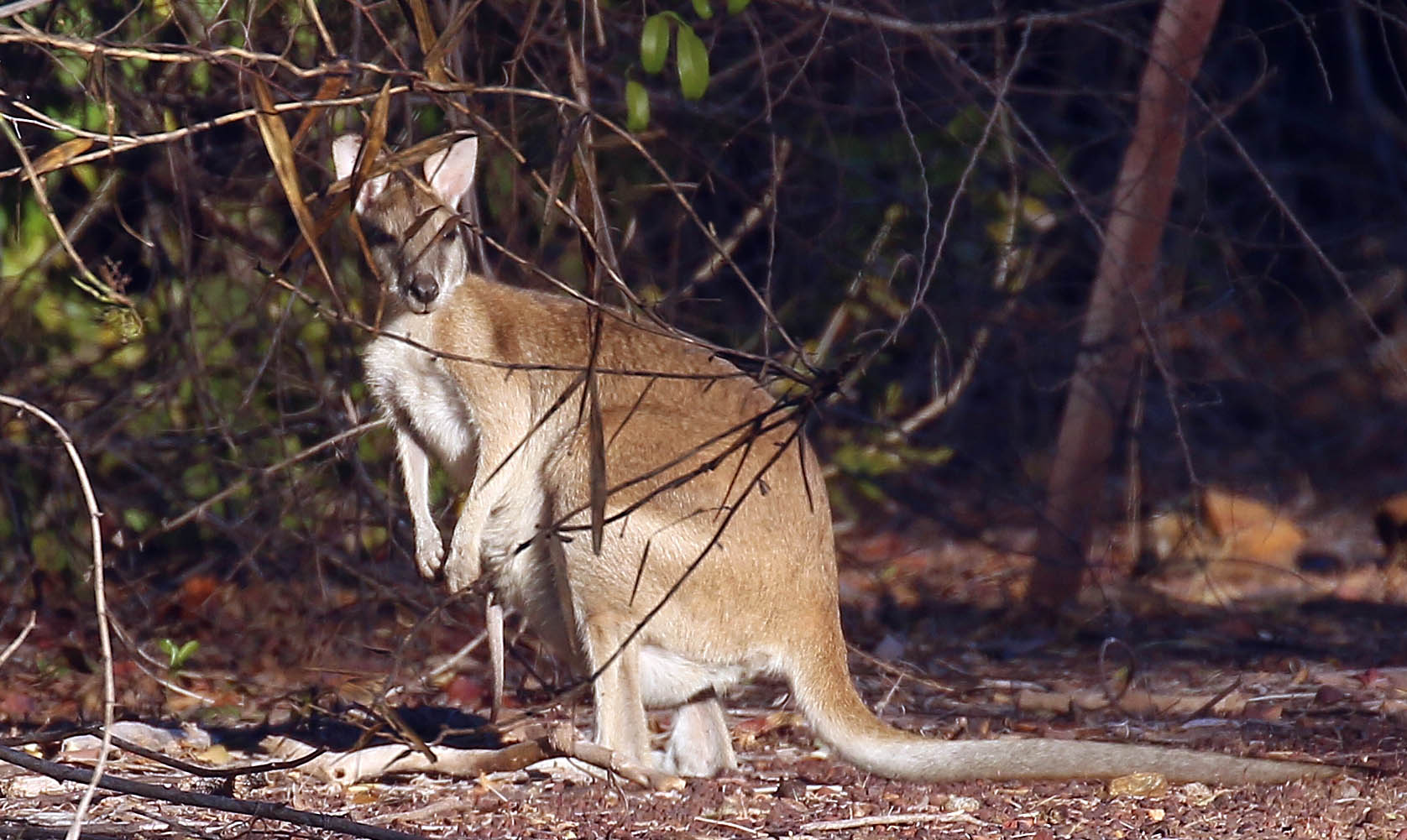 (Darwin, N.T.)
(Darwin, N.T.) 'Purple-necked Rock Wallaby', (Telstra Hill, Mt.Isa, Queensland)
'Purple-necked Rock Wallaby', (Telstra Hill, Mt.Isa, Queensland)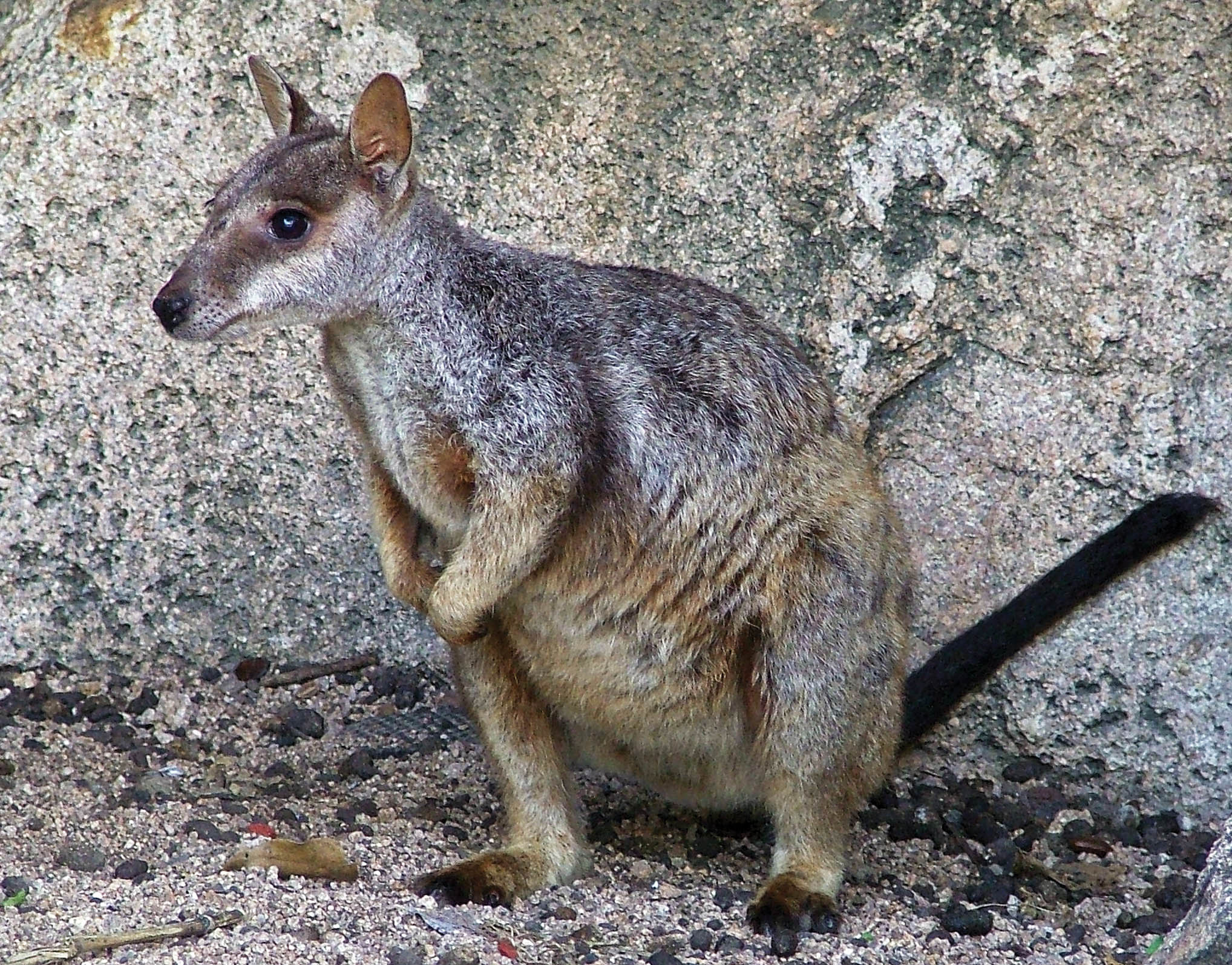 'Allied Rock Wallaby', (Magnetic Island, Queensland)
'Allied Rock Wallaby', (Magnetic Island, Queensland)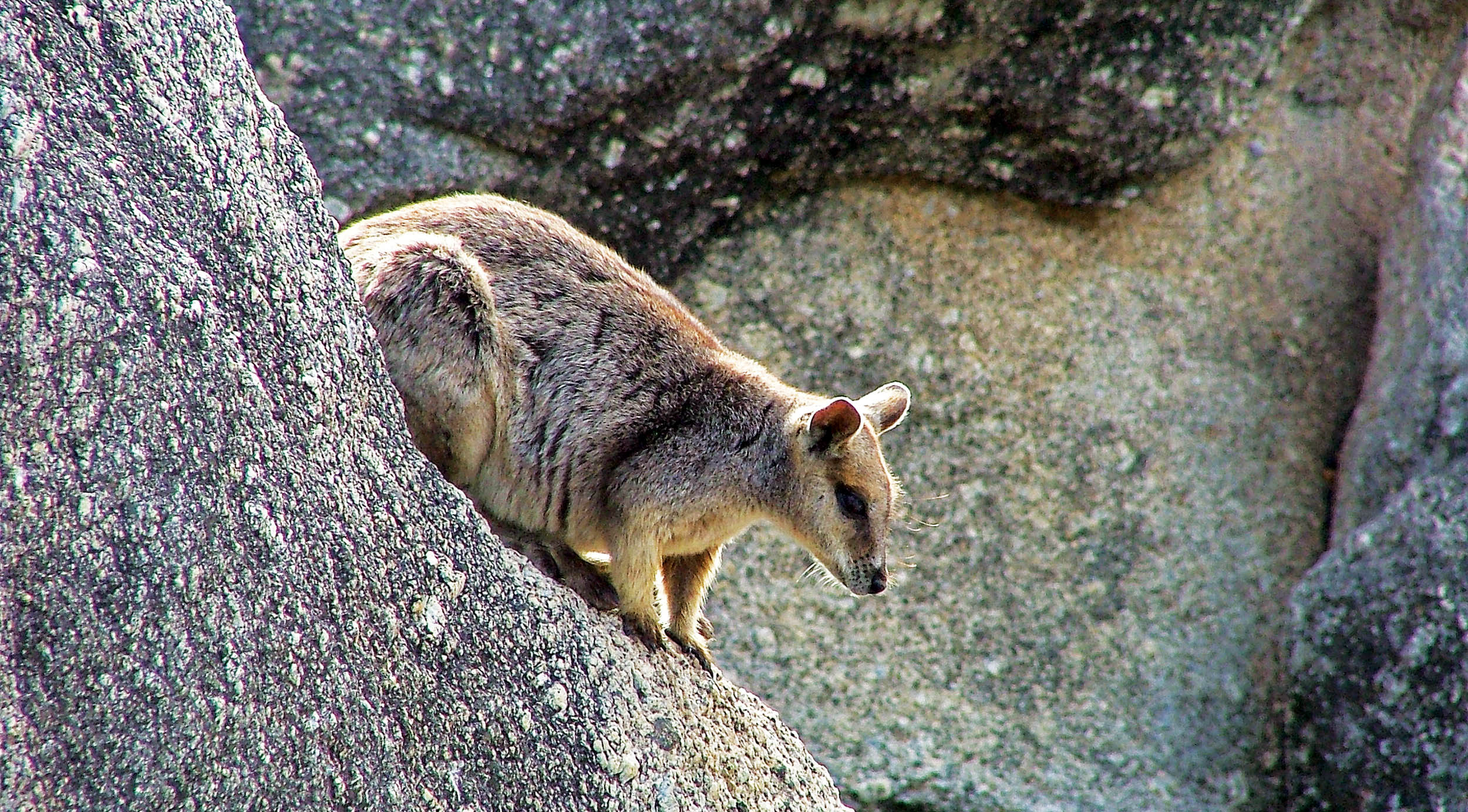 'Mareeba Rock Wallaby', (Granite Gorge, Queensland)
'Mareeba Rock Wallaby', (Granite Gorge, Queensland)Places to experience the Australian tropical savanna
Some places to explore and appreciate the tropical savanna of Australia, include: Lizard island in Queensland, and Talbot Bay and Wyndham Caravan Park, Kimberley, Australia.



